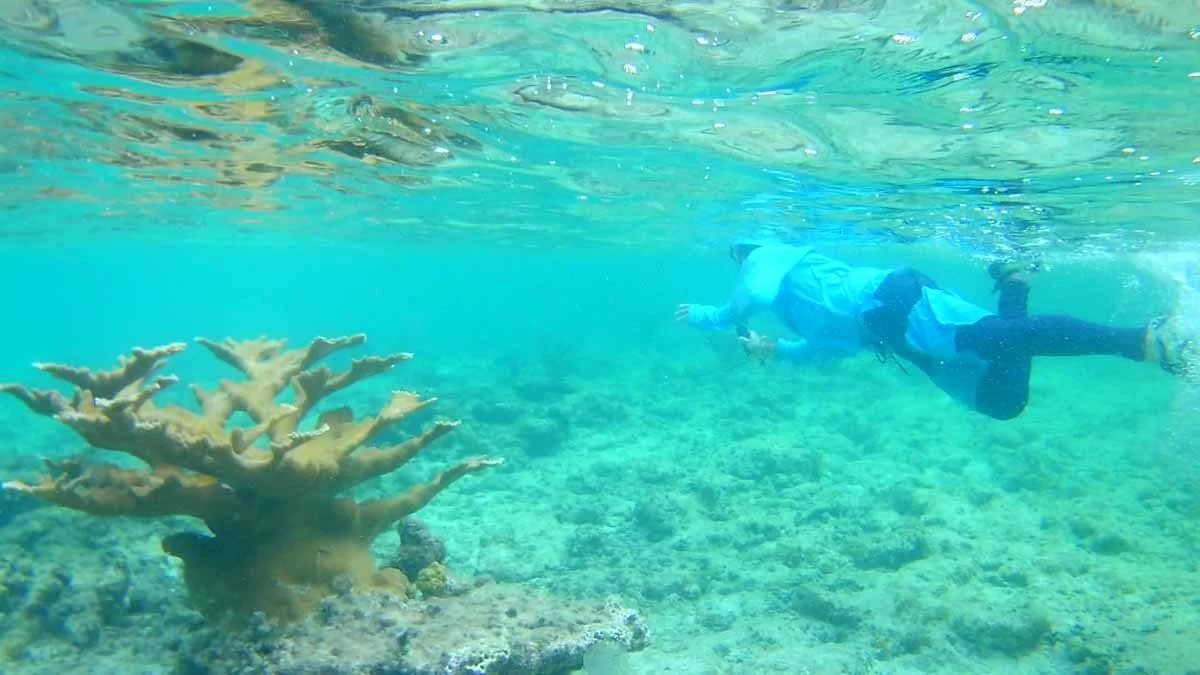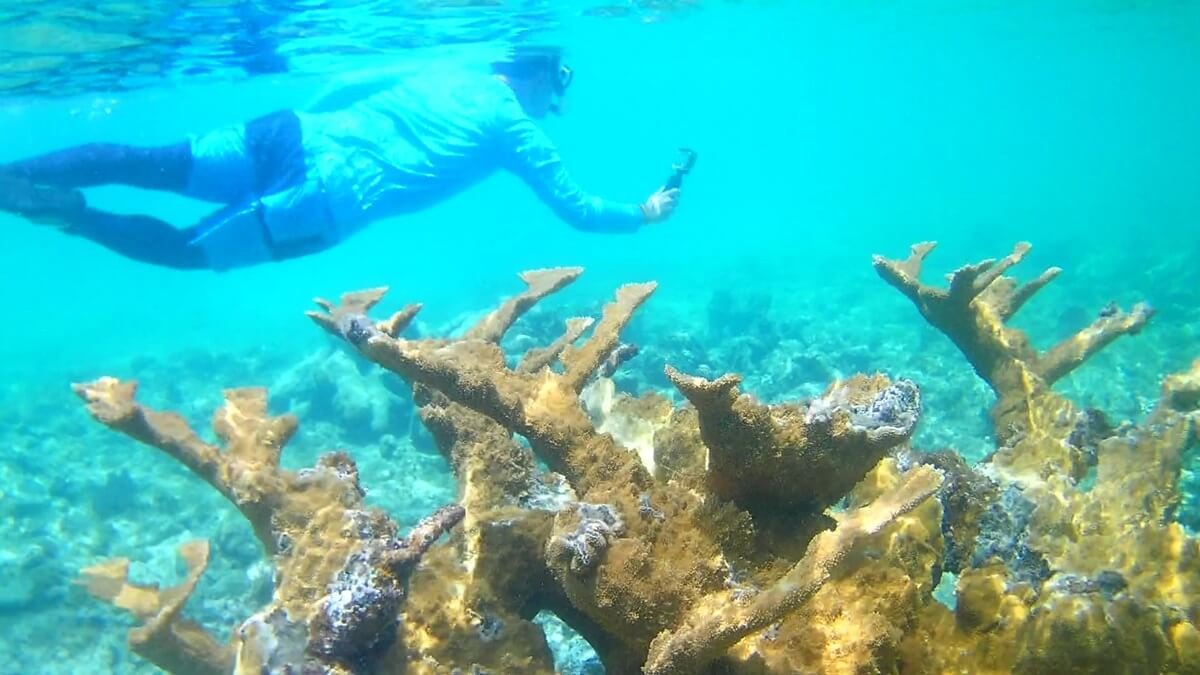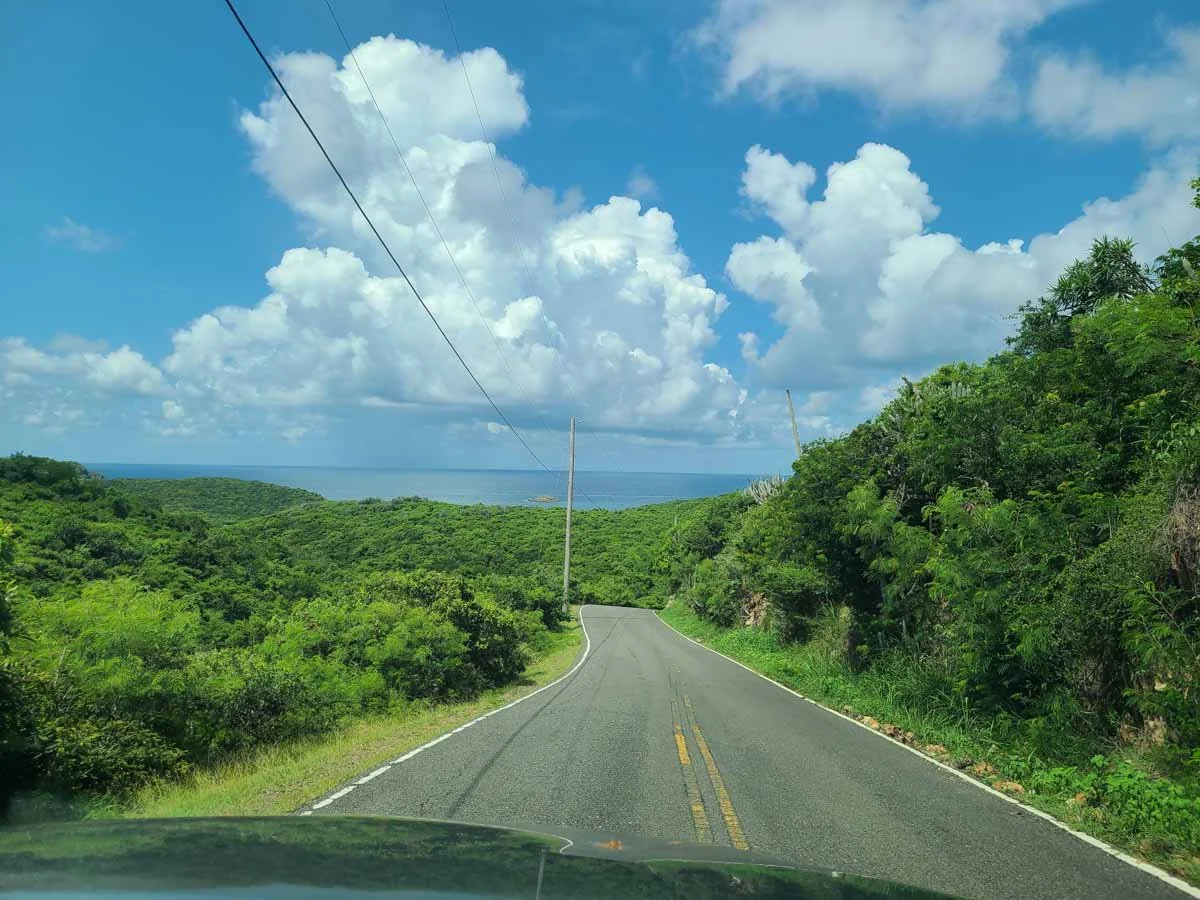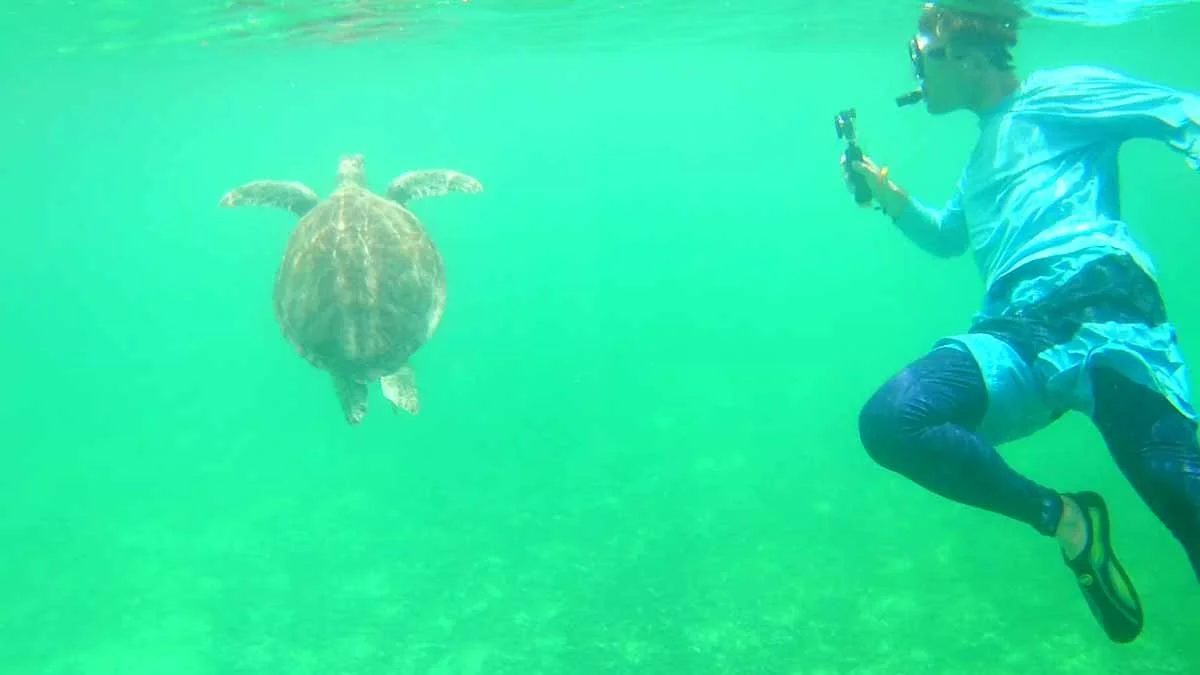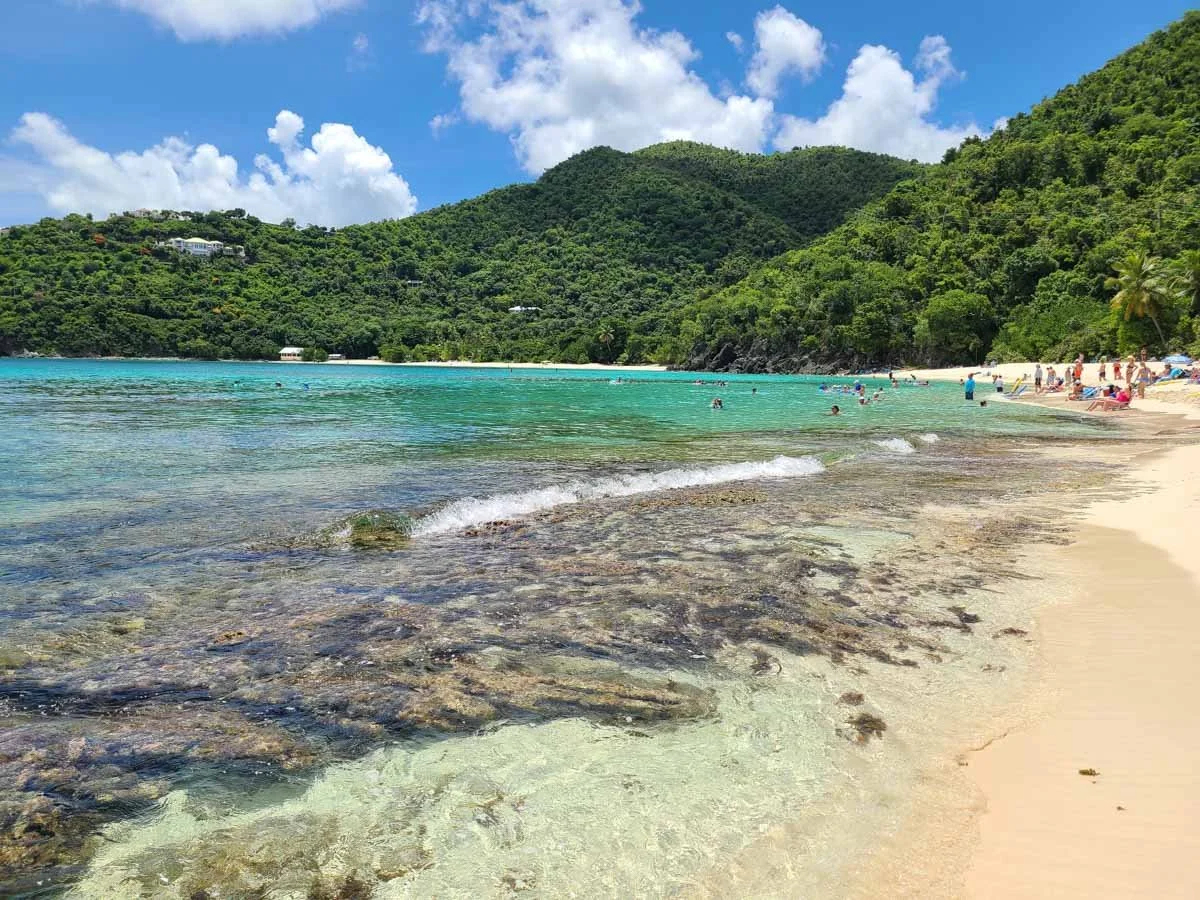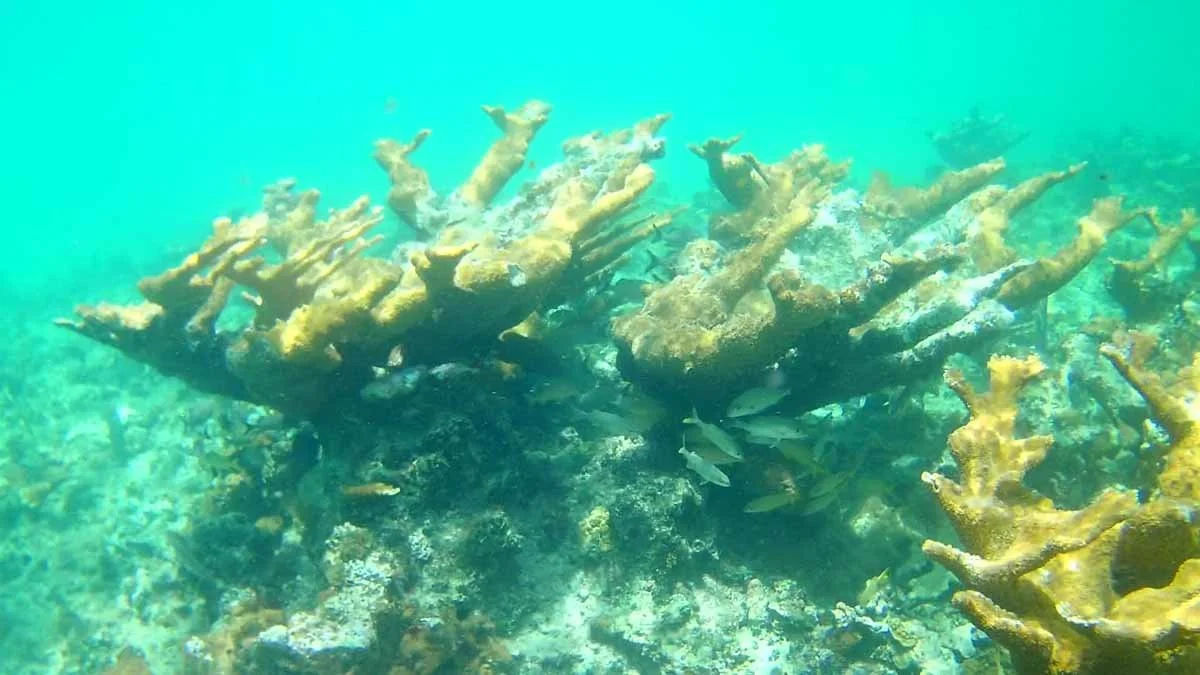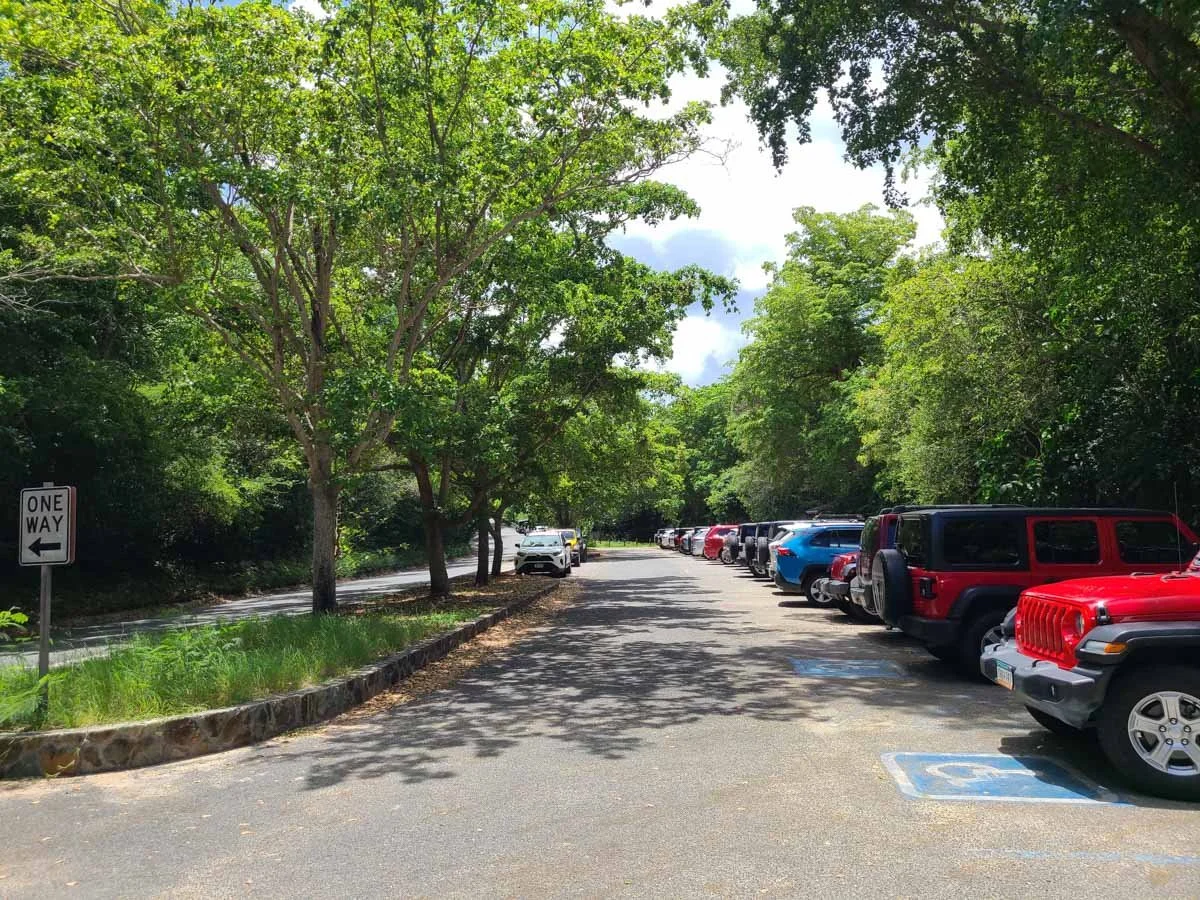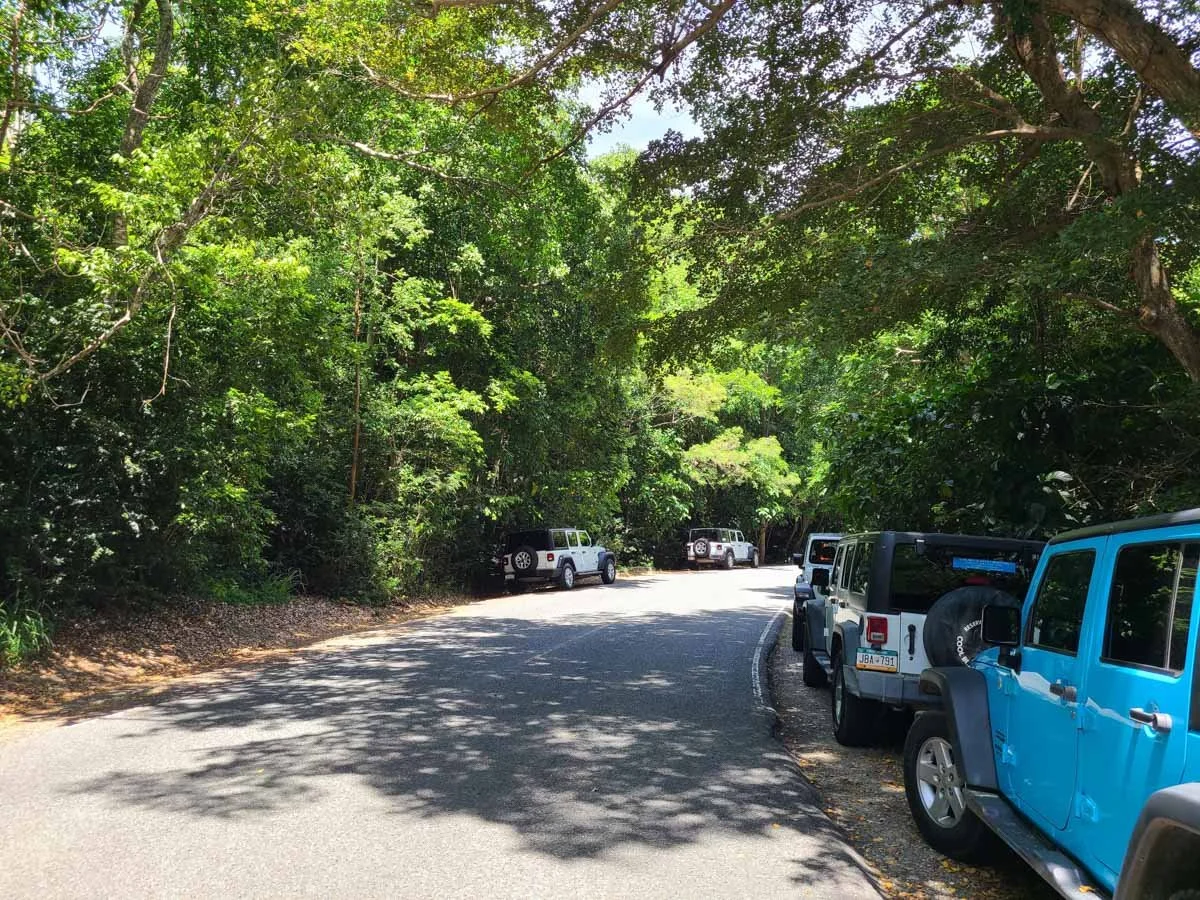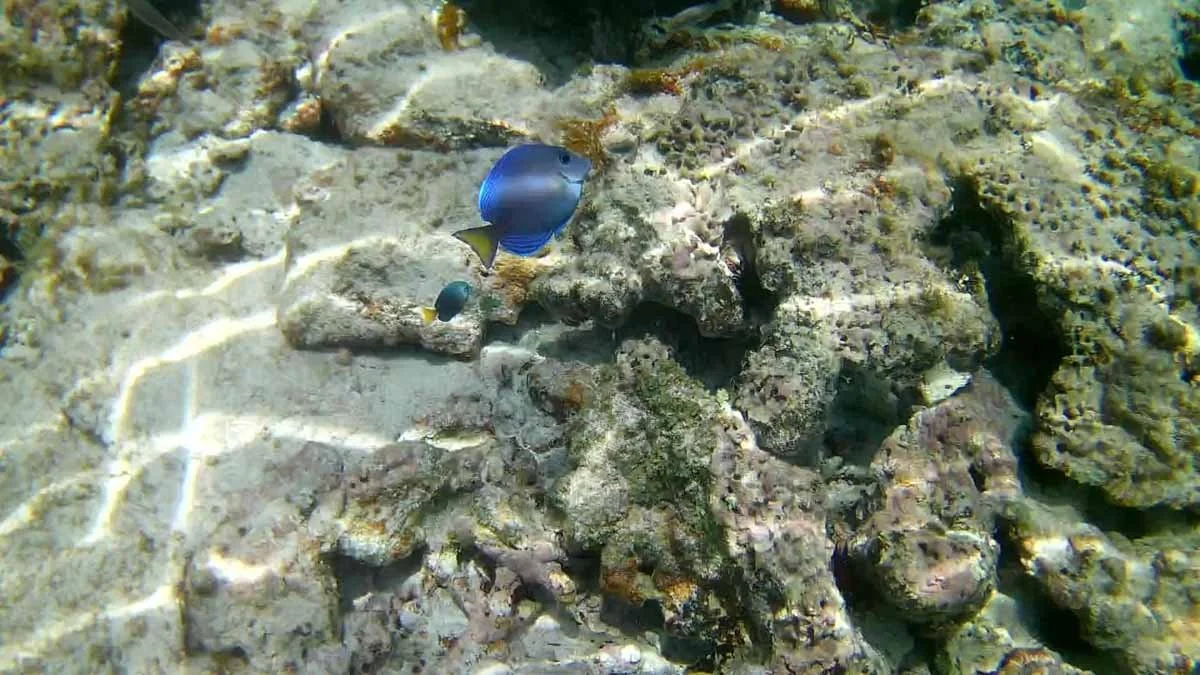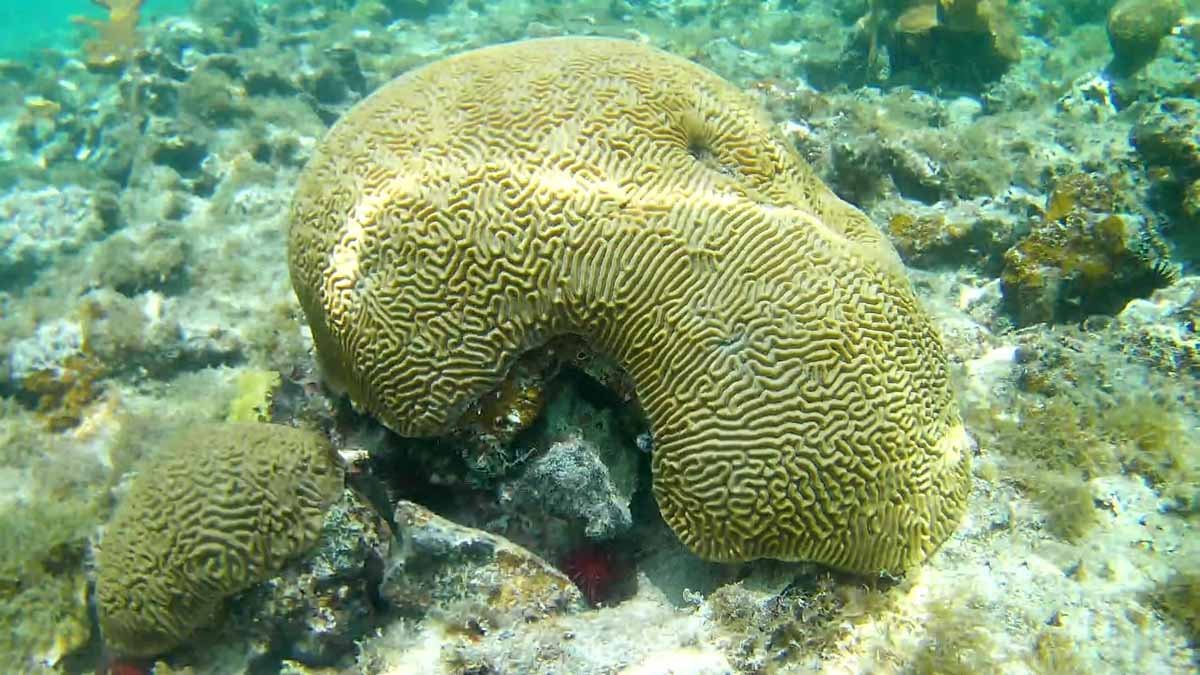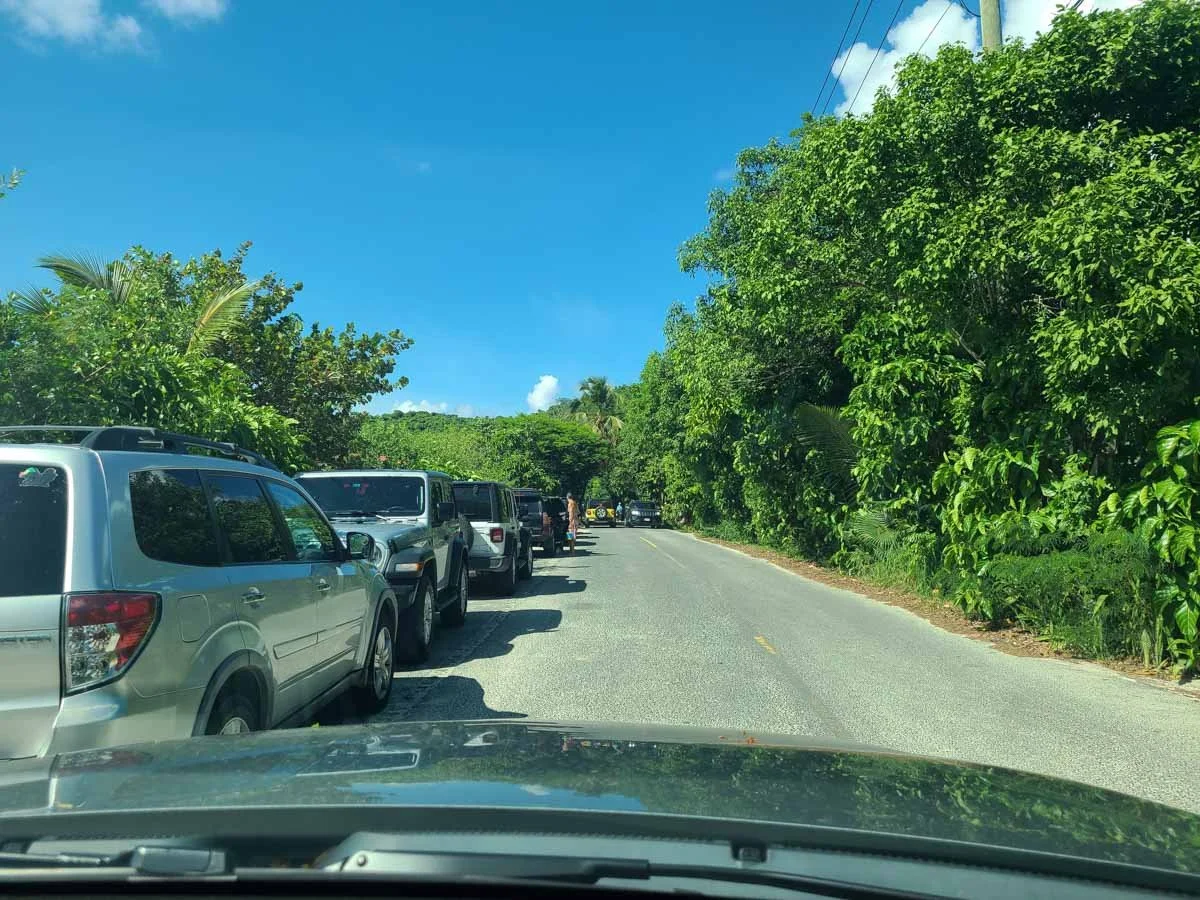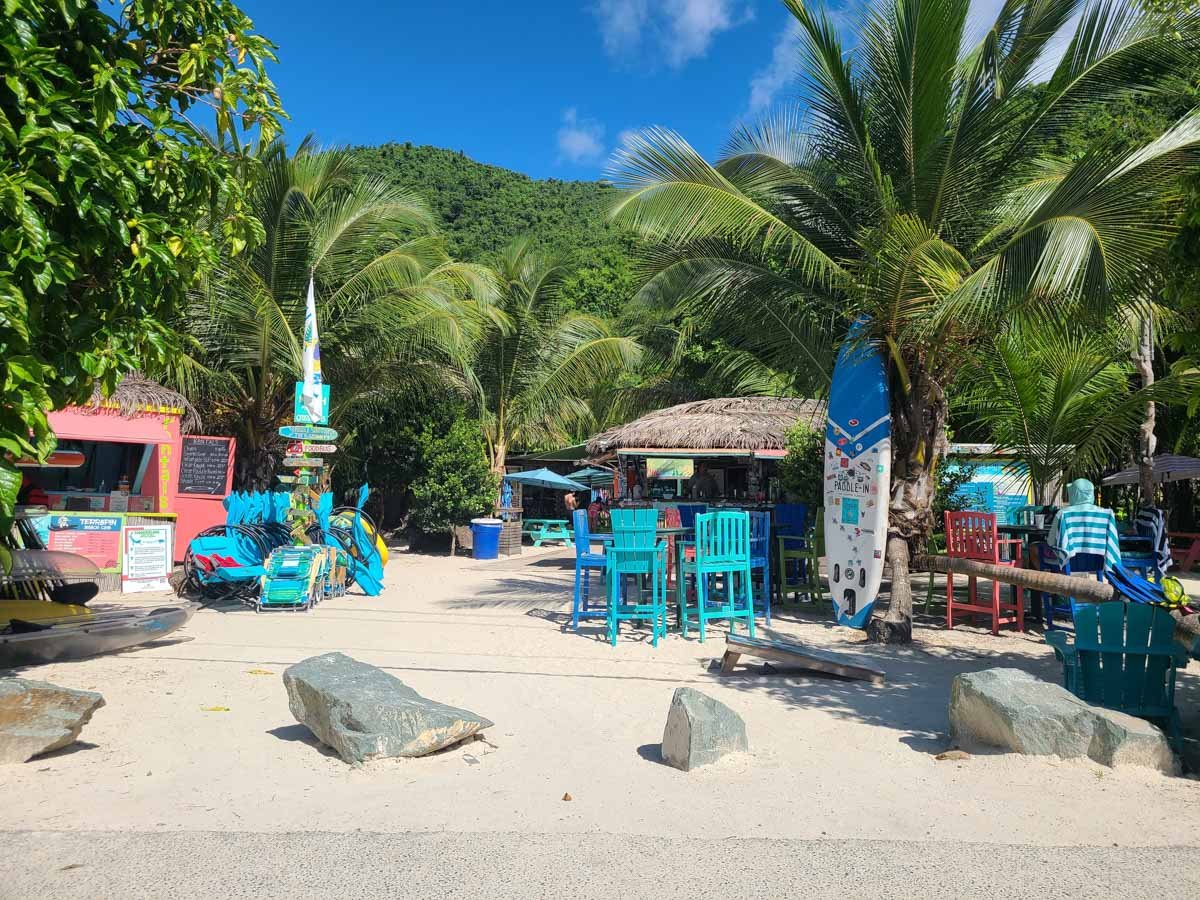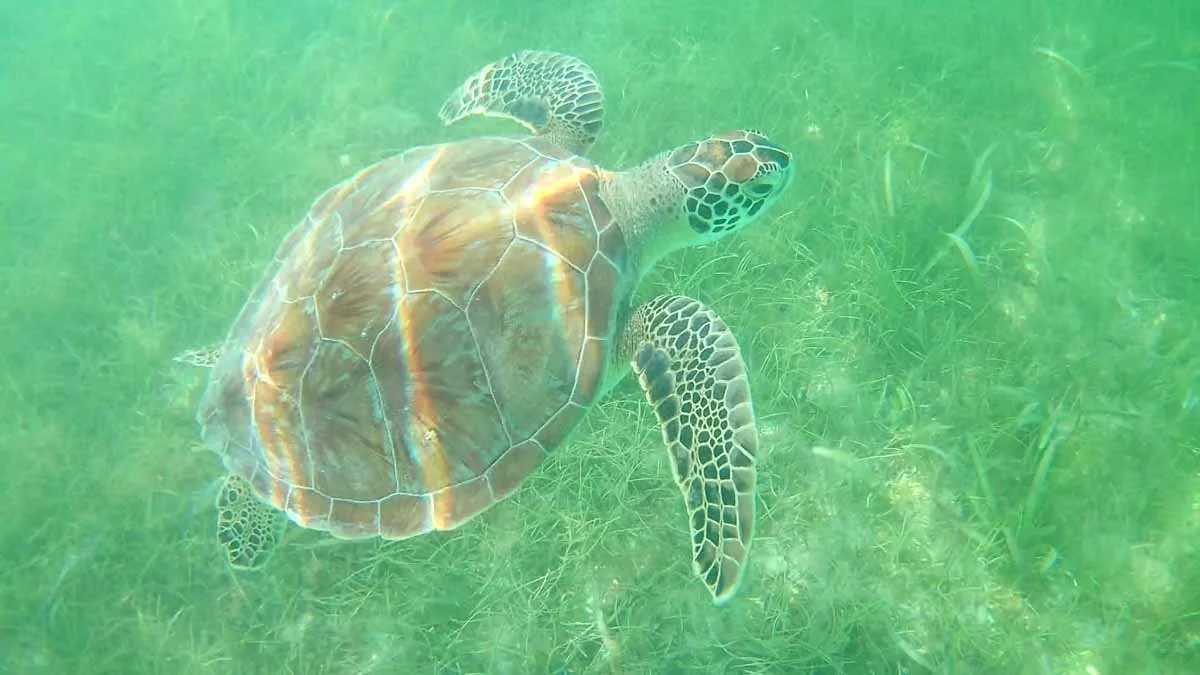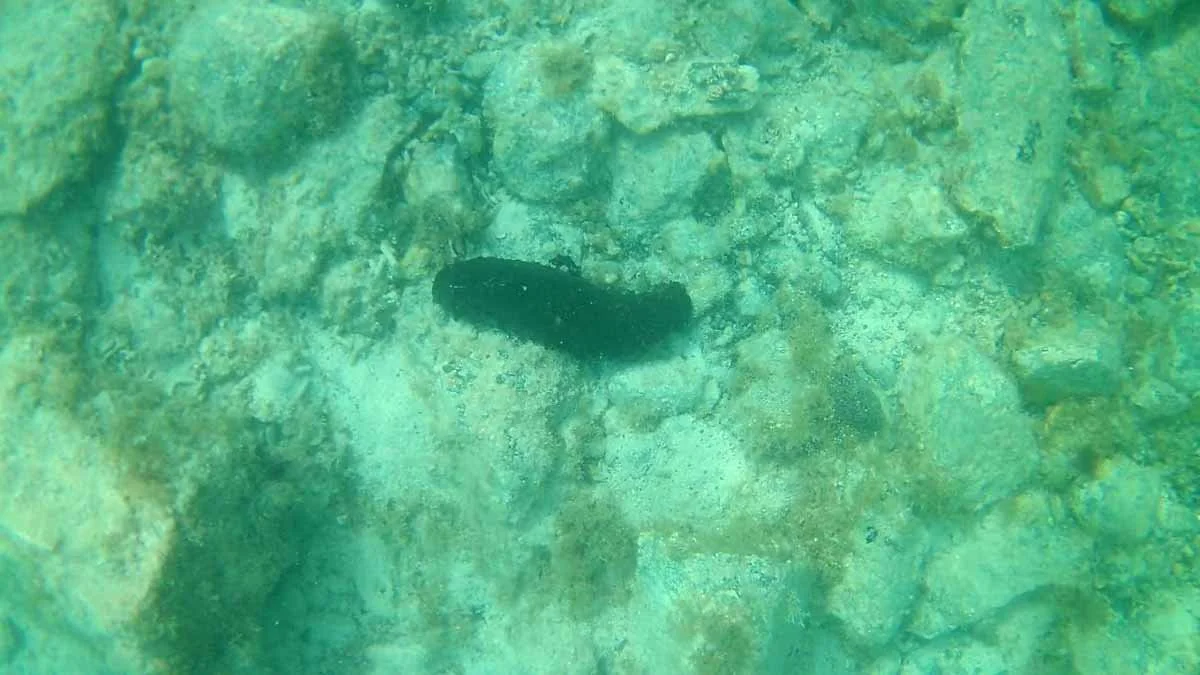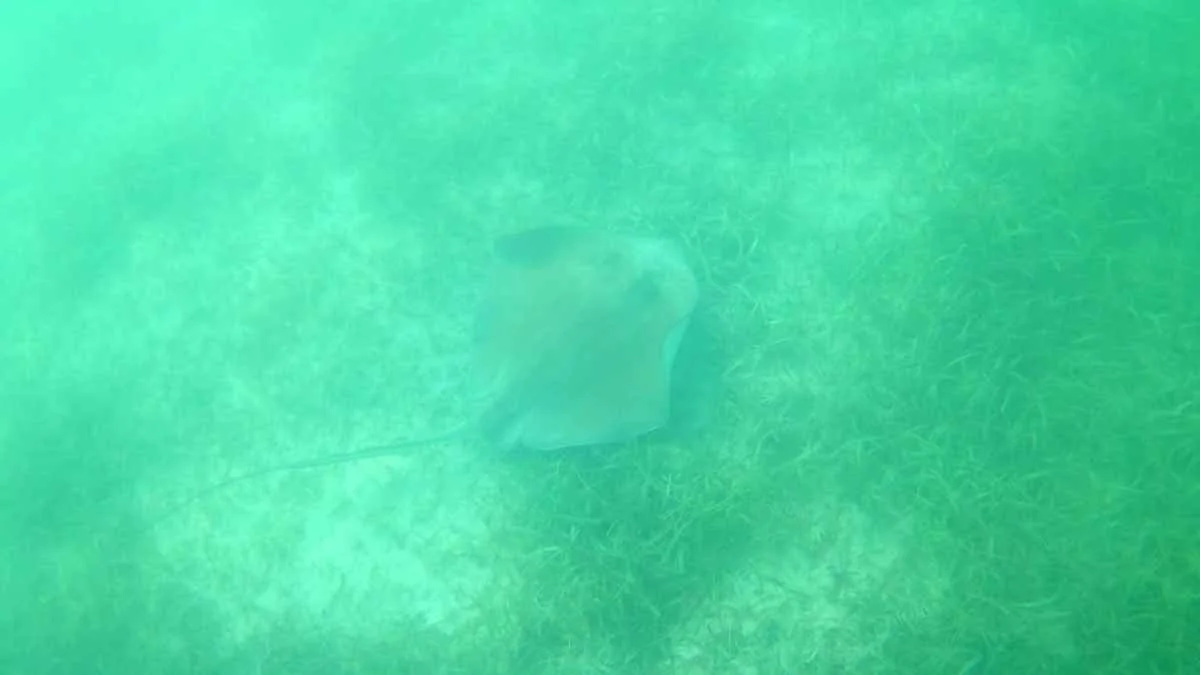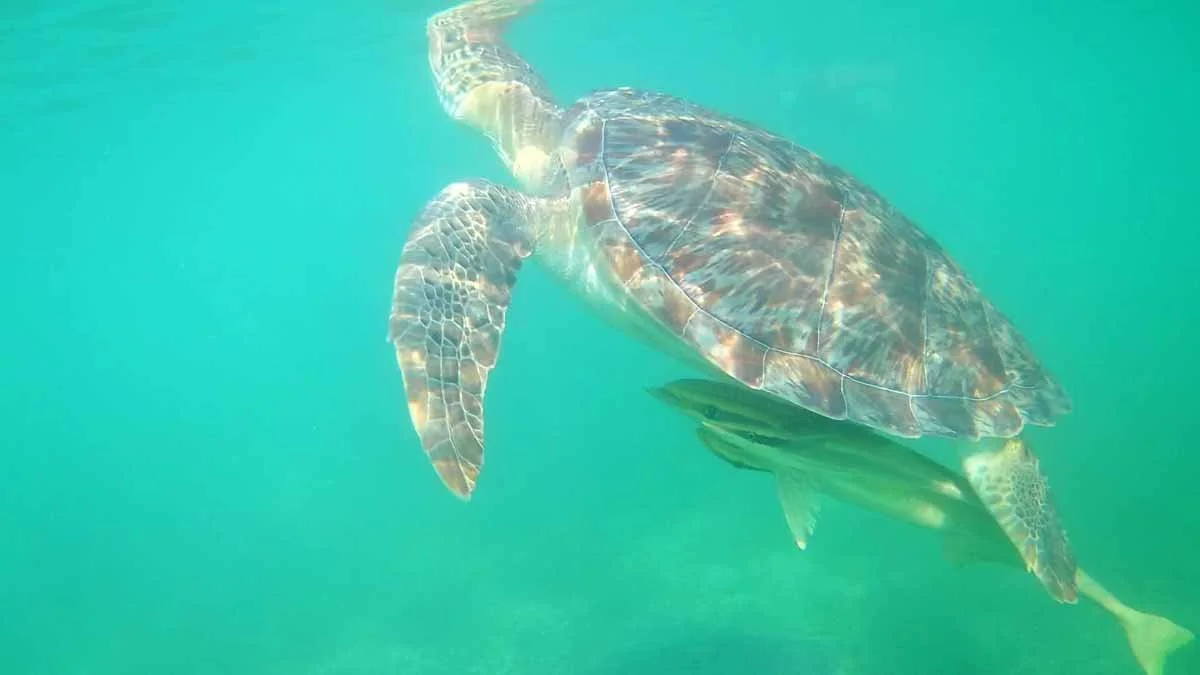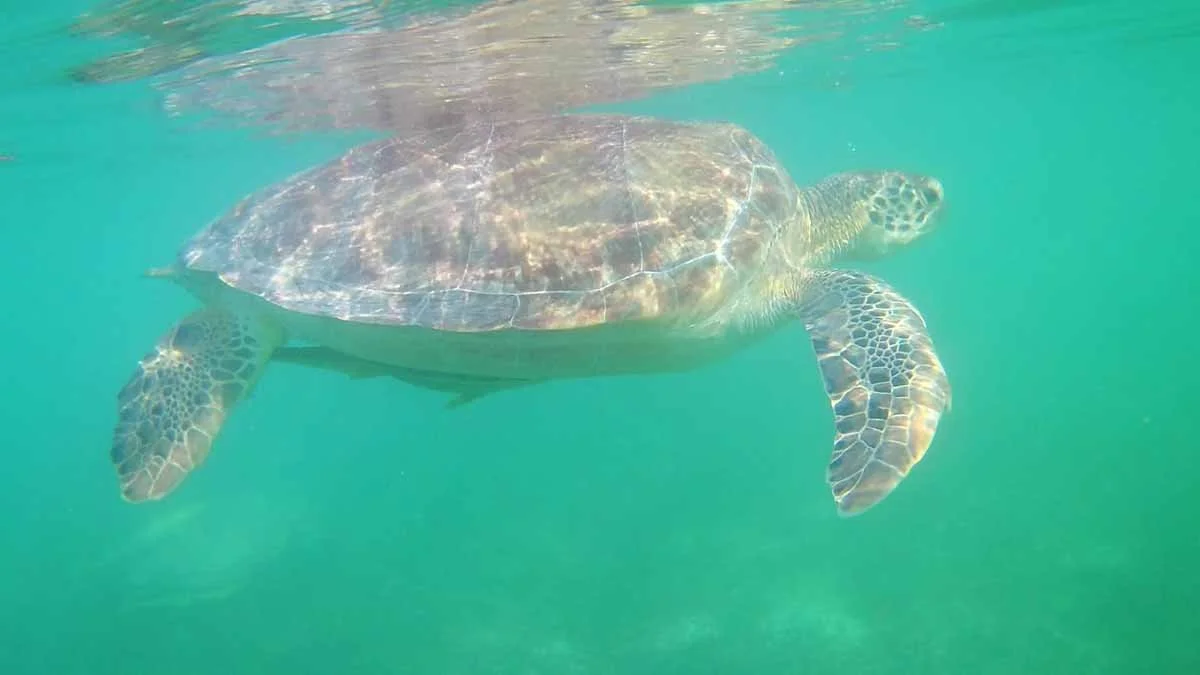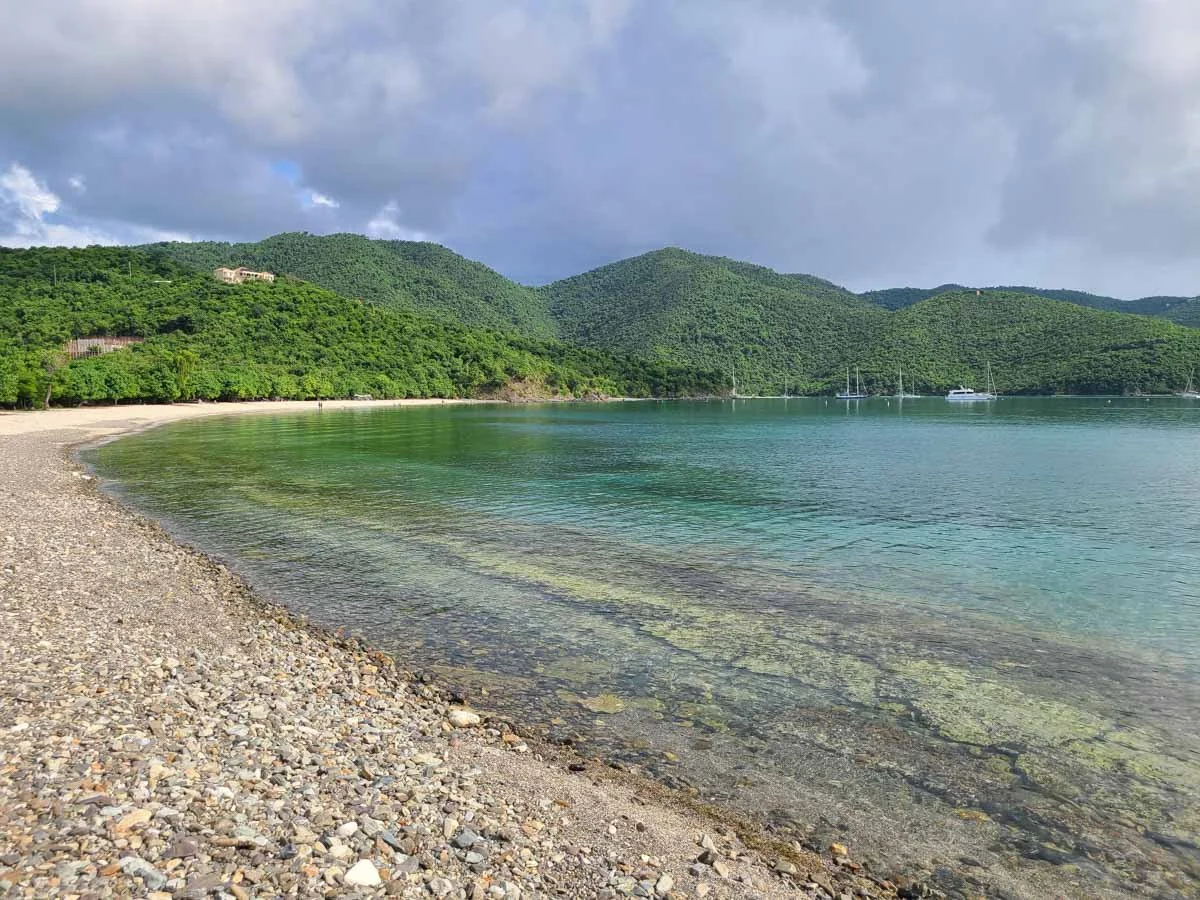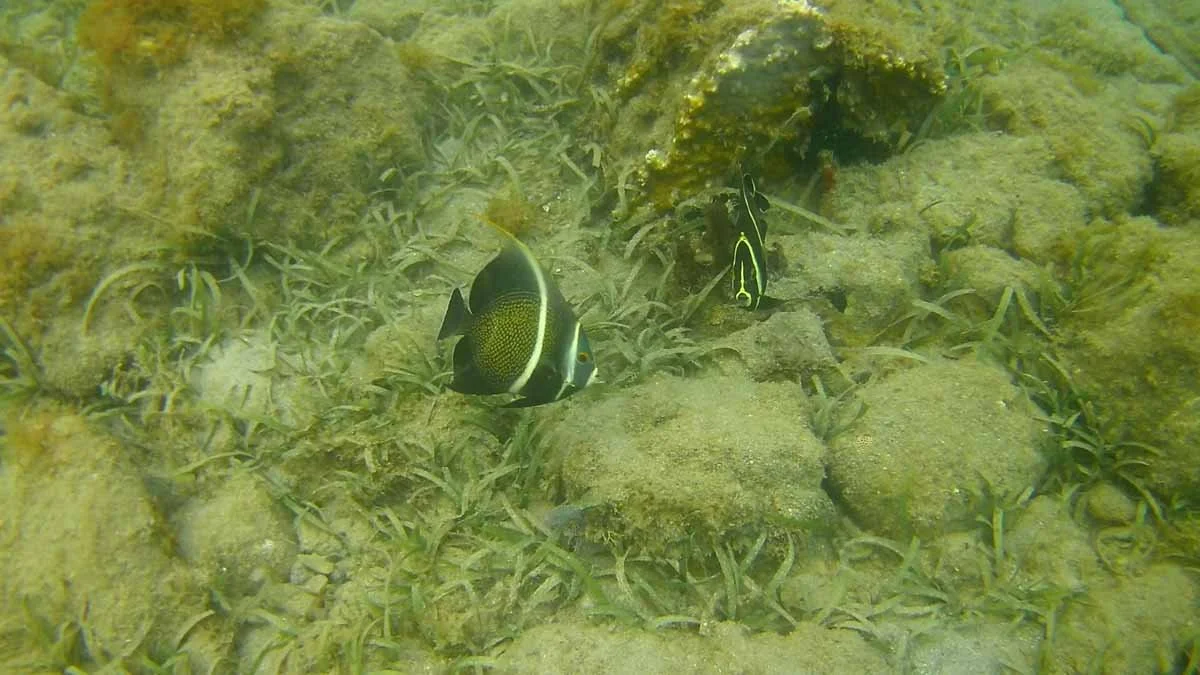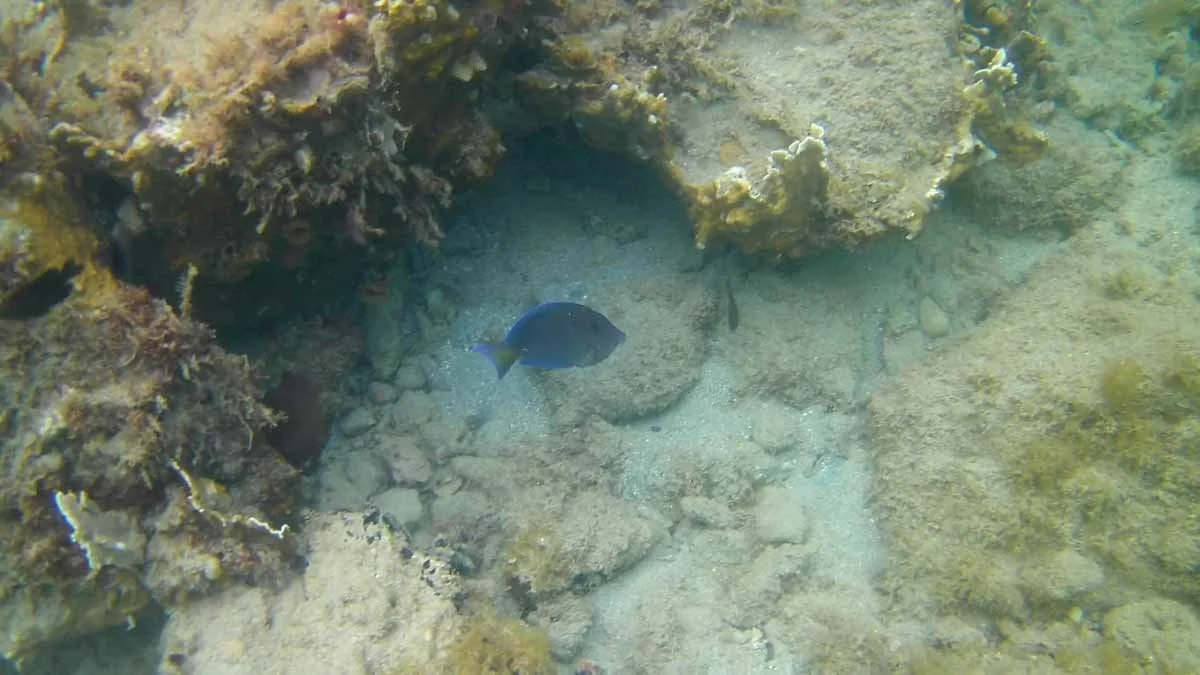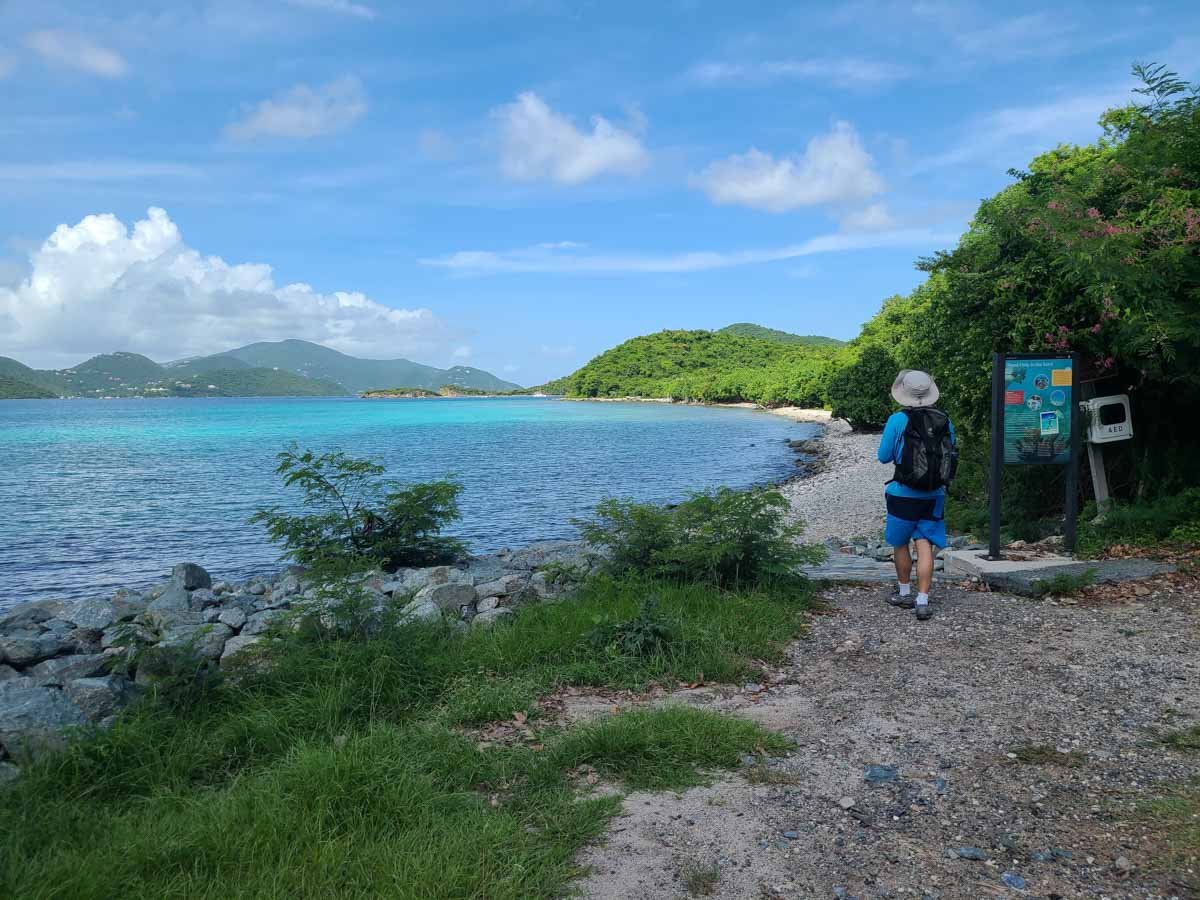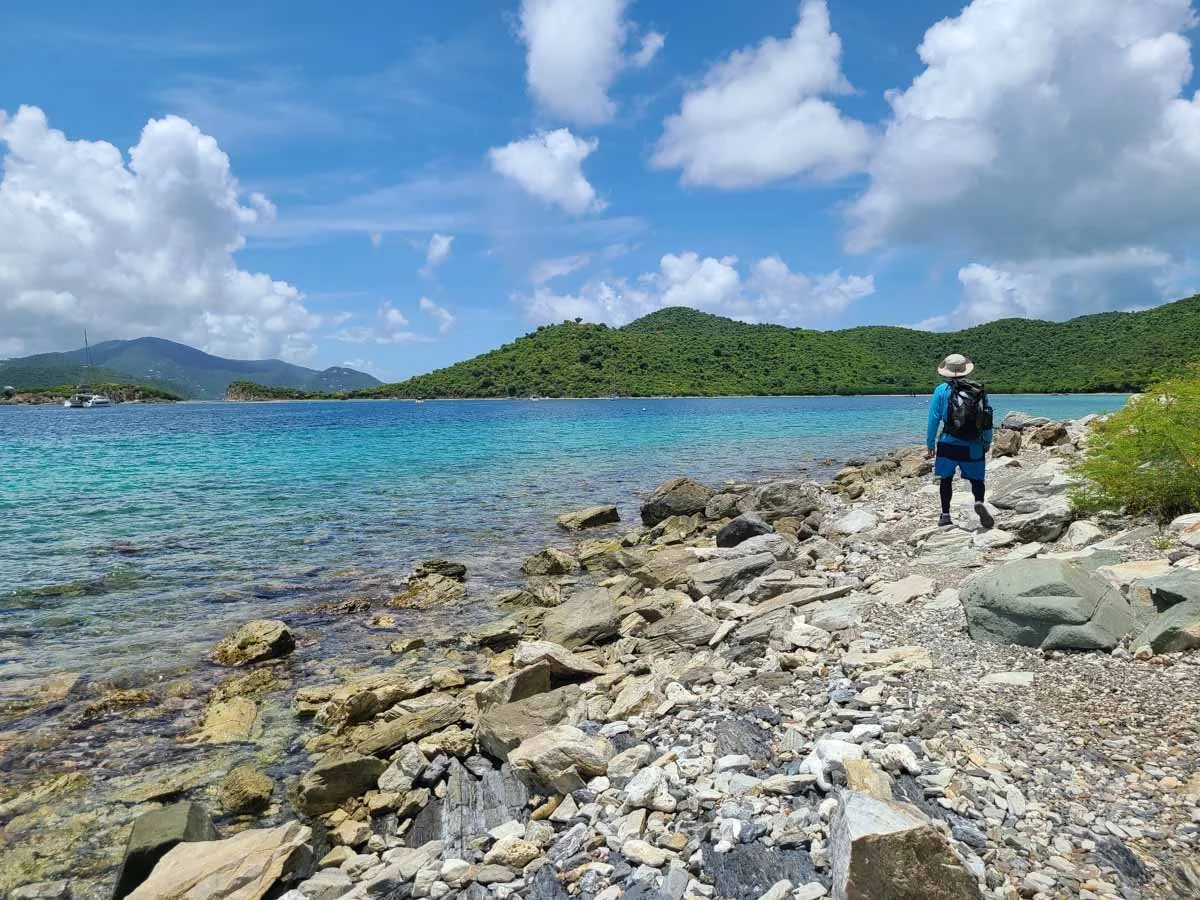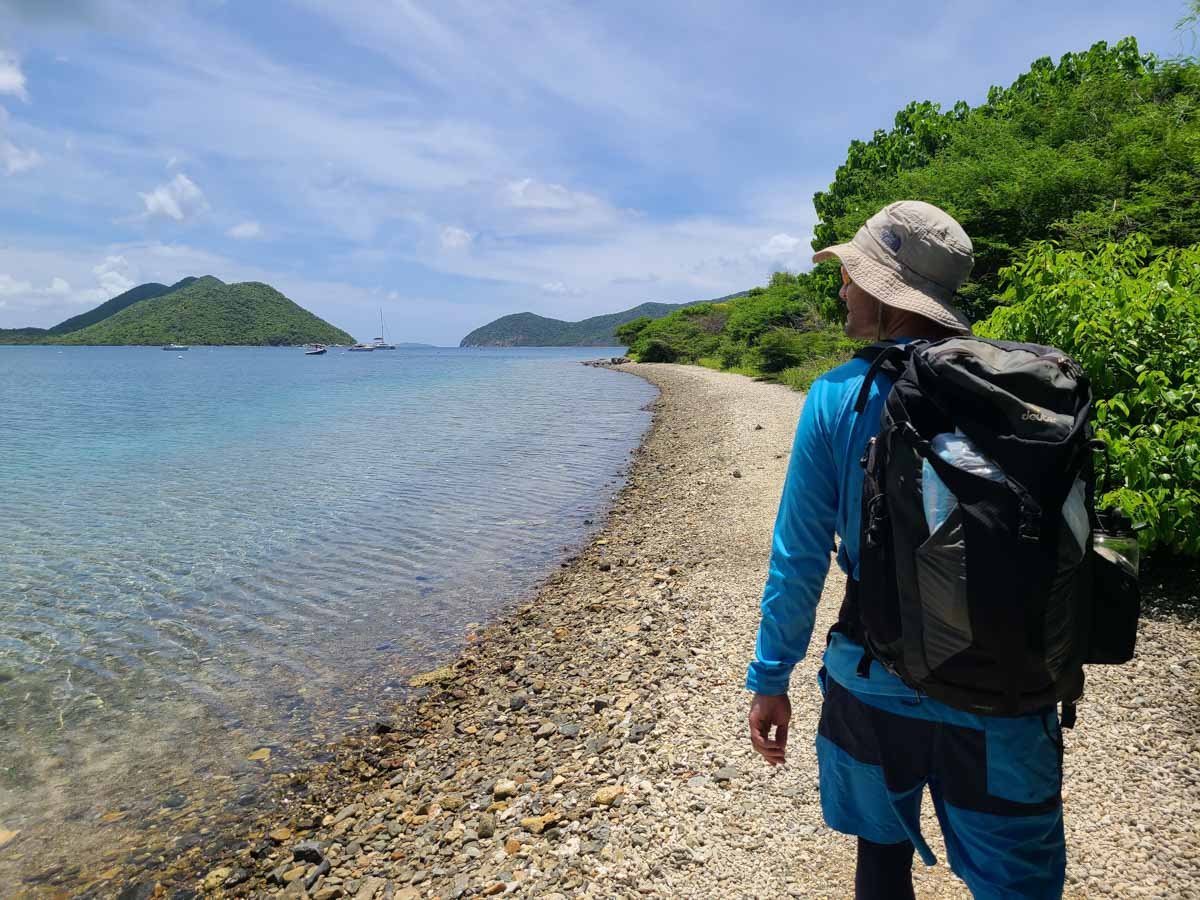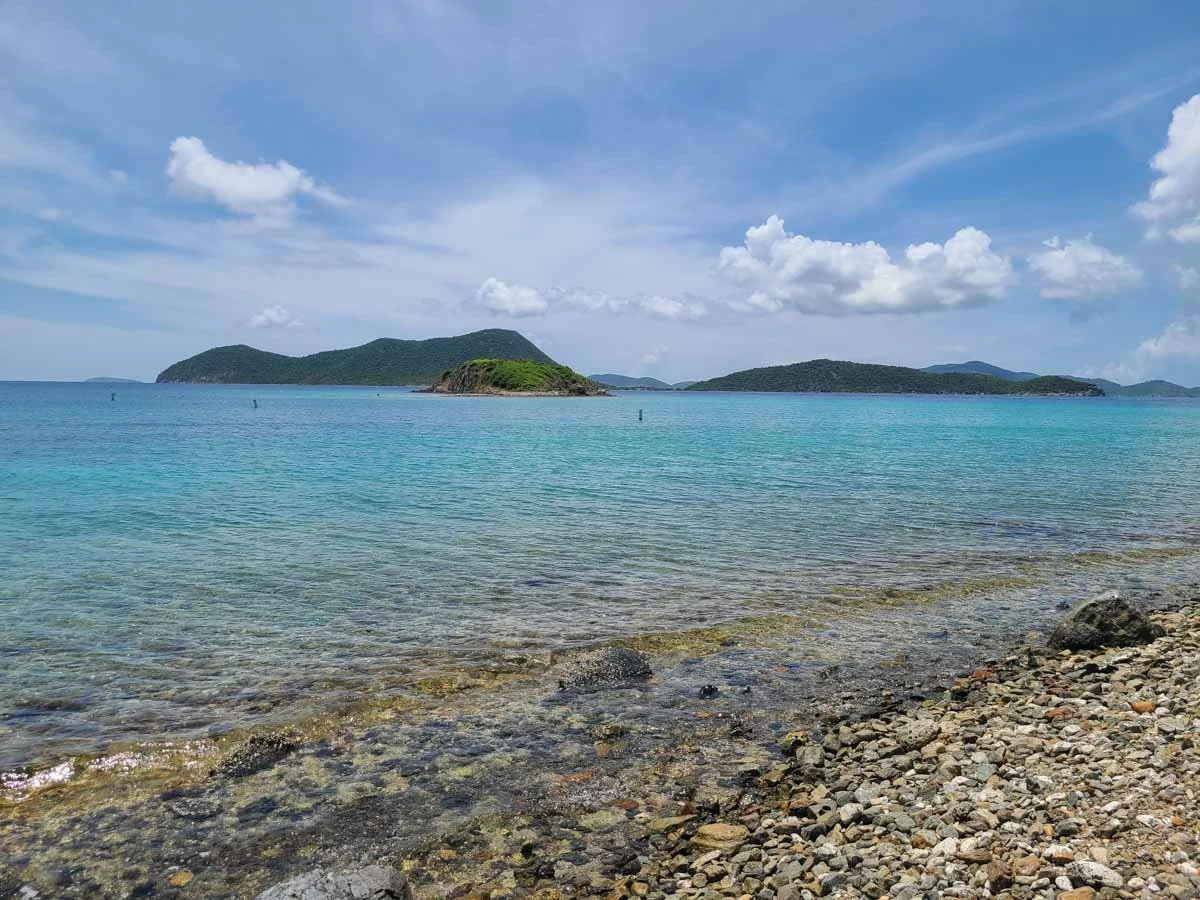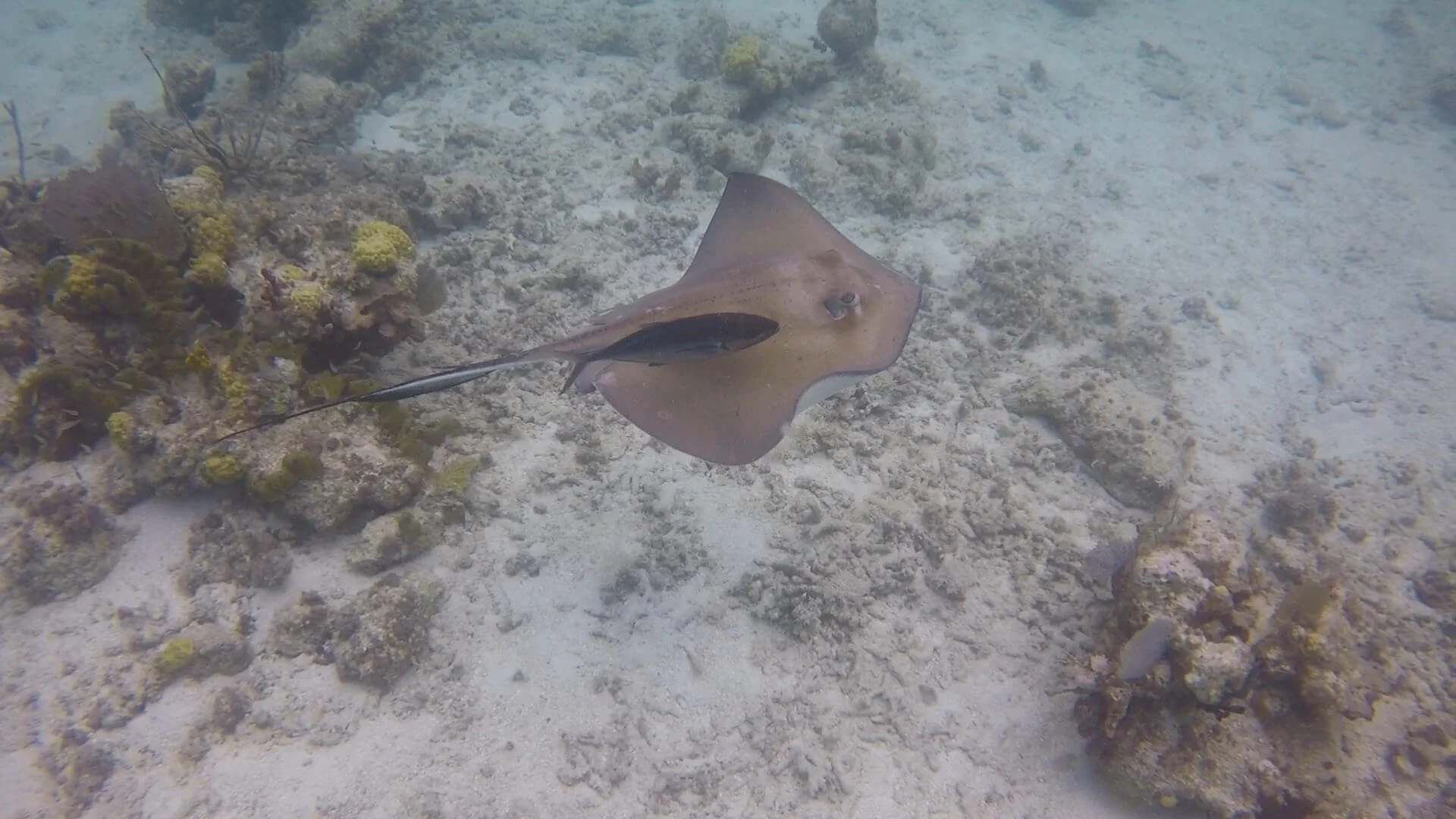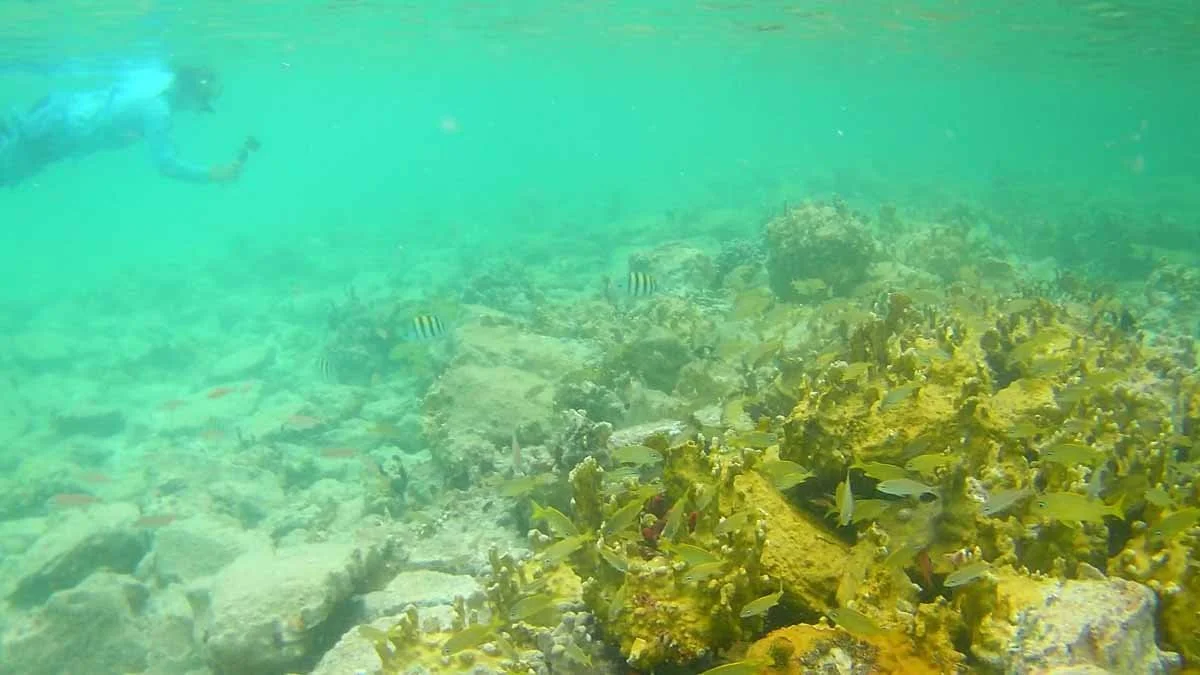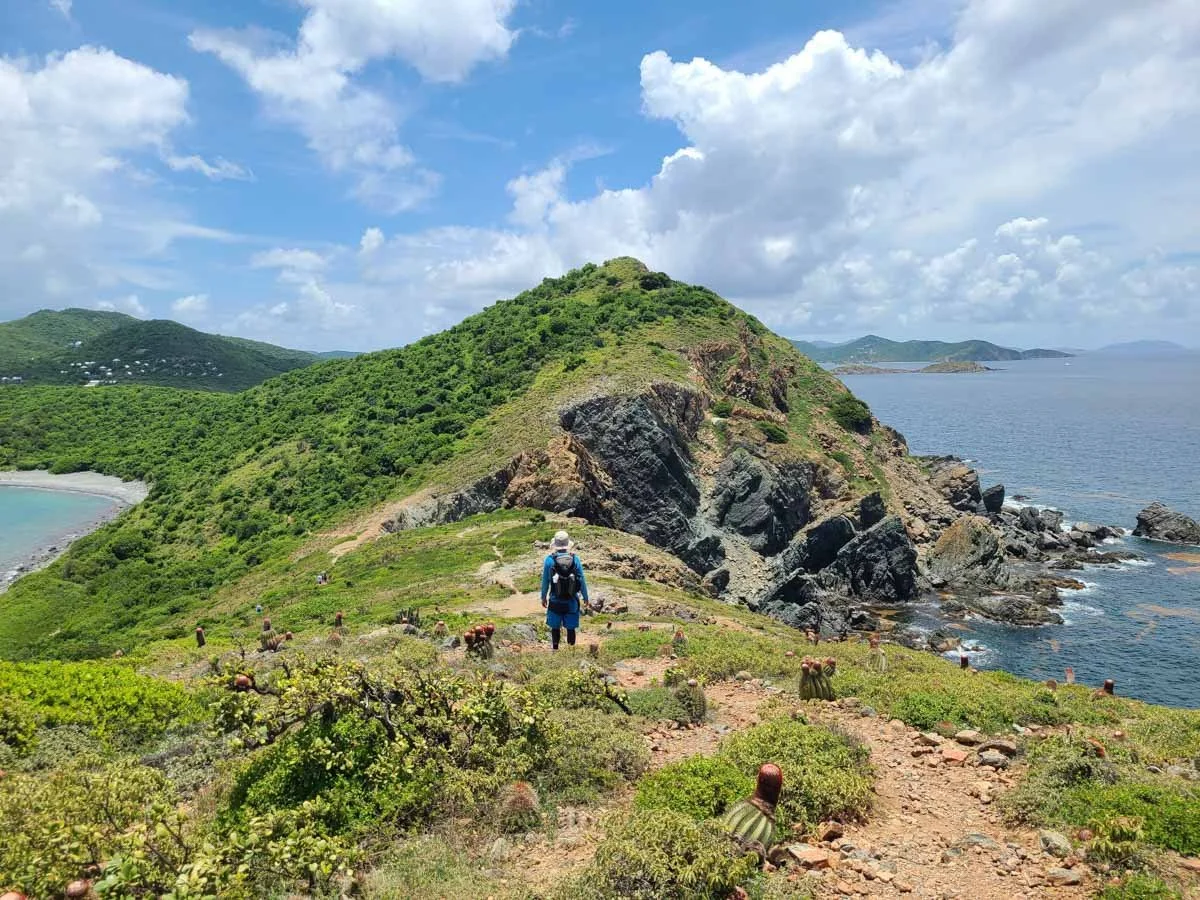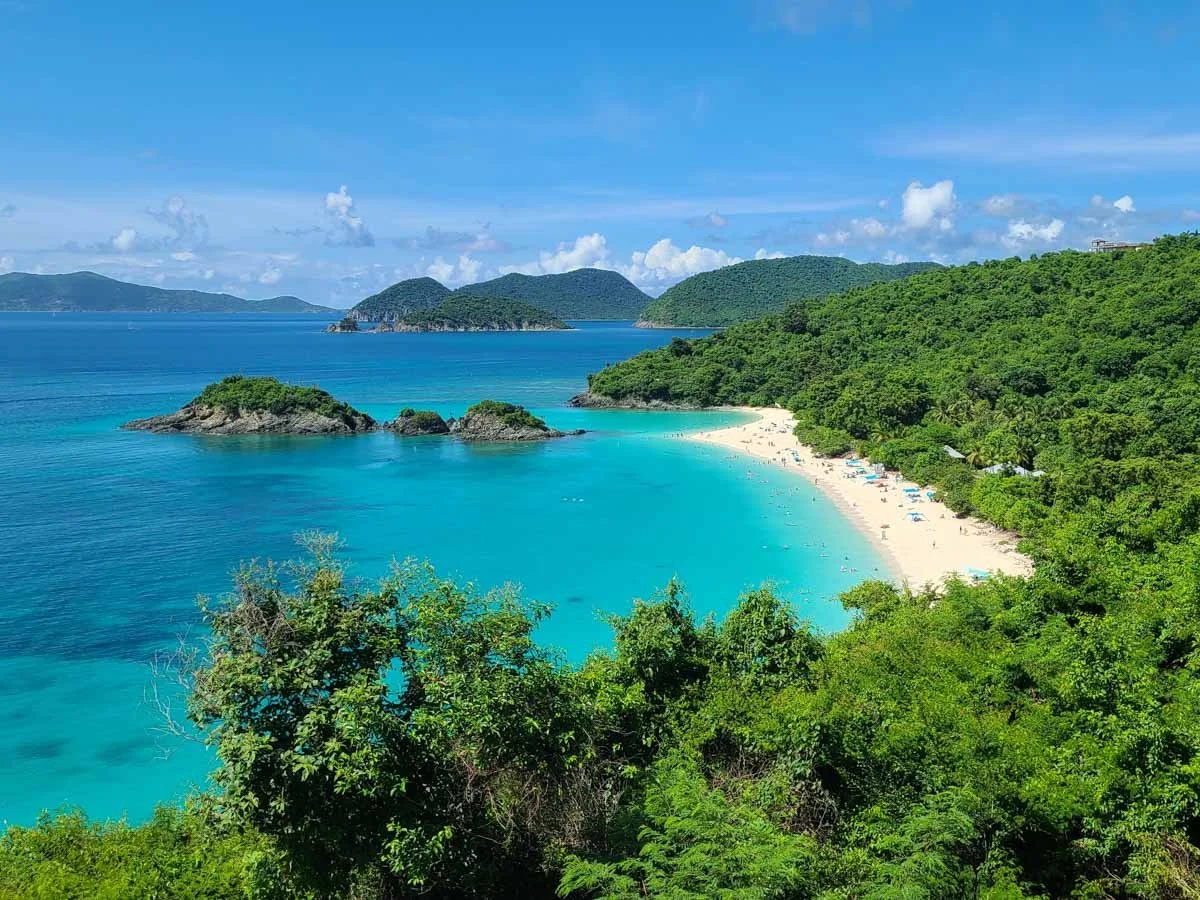5 Amazing Places to Snorkel in St. John, Virgin Islands National Park
Are you planning a visit to Virgin Islands National Park and looking for the best places to snorkel on St. John? The great news is that there are plenty of amazing spots, with beautiful coral, colorful fish, and the chance to swim with sea turtles! In this guide, we’ll go over our favorite snorkeling spots on St. John, plus give you all our best tips for your visit!
St. John is a small island in the Caribbean known for its world-renowned white sand beaches. It’s also home to Virgin Islands National Park, one of the more unique U.S. National Parks in the country and one that feels more like a tropical beach getaway than a National Park destination!
We’ll admit, we’re not huge beach people, so a visit to Virgin Islands National Park wasn’t too high up on our to-do list…but we are huge fans of snorkeling. We’ve been snorkeling in Hawaii, the Galapagos, the Great Barrier Reef, and more…so when I realized that St. John has some of the best snorkeling in the Caribbean, I started planning our trip!
And let me tell you…the snorkeling in St. John did not disappoint- its colorful coral, the variety of fish, and- the best part- the opportunity to swim with sooo many sea turtles!
And what’s really great about snorkeling on St. John is that it’s so accessible. You don’t need pricey tours to offshore locations to get to the best snorkeling- you simply have to swim right from the beaches around the island! There are plenty of shallow but amazing reefs that line the shores of St. John and provide some of the most amazing snorkeling we had ever done.
So, where should you snorkel in St. John? In all honesty, there are dozens of incredible spots around the island, and it can be pretty hard to choose where you want to go! In this guide, we’ll cover all our favorite snorkeling spots on St. John to help you narrow down your options, with information on how to get to each one, where to swim, and what you’ll see. Plus, we share all our best tips for snorkeling in St. John to help you have the best trip possible.
In this St. John snorkeling guide:
Things to Know About Snorkeling in St. John
St. John is a small island in the eastern Caribbean, known for its beautiful white sand beaches, amazing snorkeling, and breathtaking tropical views. Over half of the island and its beaches, shores, and underwater life is protected by Virgin Islands National Park, so all of the best places to snorkel in St. John that we mention here are actually a part of the National Park!
Here are a few things we think would be good to know about visiting St. John and the National Park before hitting the water.
Snorkeling through coral reef near Waterlemon Cay on St. John
When is the best time to snorkel in St. John?
In theory, you can visit St. John year-round, but we think there are a few helpful things to know when deciding the best time to snorkel on St. John.
The busiest time of year to visit St. John is between November and April. These winter months bring the mildest and driest weather, but prices and crowds will be higher. Expect to have to get to the popular St. John snorkel spots and beaches early in the morning, as parking areas are small and can fill up pretty fast.
The one thing to note about snorkeling in St. John in these winter months is that more northerly winter storms can cause swells along the beaches of St. John’s North Shore, which include many of the best places to snorkel. In the worst-case scenario, these swells can cause beaches to close for swimming and snorkeling, or otherwise can just make snorkeling conditions rough and create low visibility. I don’t think this happens very often, but it’s just something to be aware of if you want to visit in the winter. If this does happen during your visit, you can always focus your St. John snorkeling along the island’s south shore (such as at Salt Pond Bay, which we cover in our list below).
Spring (May/June) is a great time to visit St John for snorkeling. It’s a tad bit hotter and more humid than in winter (but luckily you’ll be spending lots of time in the refreshing water!). We visited St. John in June and had great weather. Any rain that we had came in short five- minute bursts that didn’t affect our day, which is typical for St. John.
June is technically the start of hurricane season in the Atlantic, but typically storms don’t form this early in the year so the risk is pretty low. Also, by spring, you’ll be out of peak season on St. John and the island will be blissfully uncrowded. We never had to worry about parking at any of our favorite St. John snorkeling spots, and never felt like anywhere was packed with people. In fact, we were always able to snorkel away from any crowds, and when we found something cool like a sea turtle, it was an extra special experience to be able to swim along with it on our own.
You’ll see plenty of colorful fish while snorkeling on St. John!
One note about snorkeling in St. John in the late winter and early spring months is the presence of “sea lice”- a form of tiny and practically invisible jellyfish larvae that can sometimes come in blooms on St. John beaches. We have typically seen reports of them sometime between March and May, but have read that they can continue through the summer as well. We had no issues with this, but have read that you will feel them as they do cause small stings, which later can form an itchy rash. They aren’t dangerous, just more annoying than anything and can be enough for you to want to get out of the water.
Throughout the summer, jellyfish can start to be more of a problem around St. John. Ones that are frequently seen are the moon jellies, which are pretty translucent, and don’t have the typical long tentacles that many jellyfish have, making them hard to see. They can produce a light sting but they aren’t dangerous. We experienced swarms of them at Waterlemon Cay (more on this below!), but we never felt any stings from them. Box jellyfish have also been seen in the water around St. John, which can have a more painful sting.
When snorkeling in St. John, we highly recommend wearing rash guards, which are long sleeve and breathable but will help protect you against stings (it might be why we didn’t feel anything from the moon jellies!).
Kevin wearing a full set of rash guards while snorkeling around coral in St. John
The months of July to October are in the hurricane season, so it’s a pretty risky time to visit and snorkel in St. John. If you happen to catch a good window without storms, it can be a cheap and uncrowded time to visit the island, but expect some things like restaurants or tours to be closed for the low season.
Can I rent snorkel gear on St. John?
If you’re planning on doing a lot of snorkeling on St. John over the course of several days, we recommend bringing your own snorkel gear with you. We were able to easily pack ours on a carry-on, and it allowed us to be super flexible with where and when we snorkeled, and it saved us some money.
If you don’t have your own gear, though, it is easy to rent snorkel gear on St. John:
There are places in Cruz Bay- the main hub on St. John- and Coral Bay on the eastern end of the island to rent snorkel gear for the day or week.
Three popular North Shore beaches- Maho Bay, Cinnamon Bay, and Trunk Bay- have on-site daily snorkel rentals.
Speaking of things to bring for snorkeling on St. John, let’s get into some other recommendations we have for what to pack…
Things to pack for snorkeling on St. John
If you plan on doing any snorkeling on St. John, we have some packing recommendations for you!
Snorkel gear- We loved having our own snorkels to take with us wherever and whenever we wanted, without having to worry about pick up and return times every day.
Rash guard- We highly recommend wearing rash guards while snorkeling in St. John. They are light weight and breathable, and usually have extra UV protection, which is super important while spending hours in the water and not reapplying sunscreen! They will also help protect your skin from accident run-ins with things like jellyfish like we talked about above. And they’re nice to have on once you get out of the water and have to do the small walk or hike back to your car, since they continue to provide that extra layer of sun protection.
Underwater camera- Make sure to have an underwater camera, because you’ll be seeing lots of cool things while snorkeling in St. John! We also like to use a camera stick that can hold small objects, like a key or some cash, so that you don’t have to leave valuables unattended on the beach!
Snorkel lens de-fogger- If you’ve ever snorkeled before, you know that foggy lenses can be a huge problem! Fogged up snorkels can really make snorkeling frustrating, so we recommend having something specifically to prevent it from happening. We used a lens cleaner called Sea Drops, which worked super well. Typically, you put just a few drops on the inside of the snorkel, spread it around, and then rinse it in the water just before putting the snorkel on. You can also use baby shampoo, or, in a pinch, your own spit!
Sun protection- The sun gets hot and intense on St. John. Make sure to have plenty of sunscreen- and make sure that it’s reef-safe sunscreen (these are ones free of oxybenzone, octinoxate, and octocrylene- as these chemicals are known to destroy coral reefs). Bring a hat, sunglasses, and even long sleeves for extra protection (yet again…I have to mention rash guards- those things were the true MVPs of our St. John snorkeling trip!).
Hiking/walking shoes- Even though you might be planning on spending most of your time on beaches and in the water while in St. John, we highly recommend you bring more than just your flip flops! To get to some of the best snorkeling spots on St. John (and even some of the most amazing beaches), you’ll have to do some short hikes. The terrain on St. John can be pretty rough and rugged, and you’ll want to have a good pair of hiking or walking shoes. Pack in your beach shoes and/or water shoes and change into them once you get to the beach.
Some of the best snorkeling spots on St. John require a rocky walk!
Bug spray- Some beaches had lots of mosquitos, and we really wished we had some bug spray!
Water- Bring plenty of water with you wherever you go each day. It’s super hot here and after hours of swimming and being on a sunny beach, you’ll need to make sure you stay hydrated.
Do I need to go on a tour to snorkel in St. John?
There are tons of snorkel tours on St. John. Some are with more local companies, like Cruz Bay Water Sports and VI Ecotours, and others are through bigger online companies like Viator.
We personally don’t think you need to take a snorkeling tour on St. John, because honestly, you can find some of the best St. John snorkeling right off the shore of many of the island’s popular beaches.
Depending on the tour, some will last all day and include other things in addition to snorkeling, such as hiking, kayaking, or sailing, so if you want a full day multi-activity excursion with everything pre-planned, then tours are definitely an option. Some also go to more remote snorkeling destinations that are further from shore, or to beaches that are only accessible by boat. This could be appealing because there won’t really be many people there, which could also mean that the marine life might be more abundant- another good reason to do a St. John snorkel tour.
If you don’t have your own transportation and didn’t rent a car on St. John, taking a tour might make things a little easier for you, too, since they will provide all the transportation.
If you do have your own car, though, we found that snorkeling at the accessible locations right off the St. John beaches was amazing (and it will save you some money!). We saw tons of colorful coral, a huge variety of fish, swam with more than a dozen sea turtles, and spotted a few other cool sea critters like starfish and an eel!
So that brings us to our next question…how do you get to all these amazing St. John snorkel spots without a tour?...
How to get to the best places to snorkel on St. John
The best way to get around St. John is to rent a car. The island is pretty small, so it doesn’t take much time to get from place to place, but the roads can get very winding, narrow, steep, and bumpy, so it’s important to drive slowly and cautiously! Also, driving is on the left in St. John!
Driving on St. John
Cruz Bay, on the western end of the island, is the main hub of St. John where you’ll find most accommodations, restaurants, and the ferry docks. Most likely, you’ll be basing yourself near here and then doing day trips to various places across the island.
There are really only two main roads that run across St. John- North Shore Road and Centerline Road. These connect Cruz Bay on the west side of the island to Coral Bay on the east end of the island. Most of the best snorkeling spots on St. John are found along North Shore Road, with a couple located on the south shore past Coral Bay. For each of the St. John snorkel spots we mention in this guide, we’ll be sure to tell you exactly how to get there!
If you don’t have a car on St. John, another way to get to the St. John snorkeling spots is to take taxis. Truck taxis can be easily found throughout Cruz Bay, and they have set rates for all the popular places around the island.
For tons more information about getting around St. John by car or taxi, be sure to check out our Complete Guide to Virgin Islands National Park on St. John!
More tips for snorkeling in St. John
Before we get to all the best spots to snorkel on St. John, here are some final tips to keep in mind for your visit!
Respect the wildlife- This is an important one! As you’re snorkeling in St. John, you’re likely to see lots of cool critters. Please remember to keep your distance and don’t try to touch or otherwise startle them. This holds true especially for turtles.
Sea turtles are a protected species on St. John, and touching them or otherwise disturbing them can lead to hefty fines and even jail time.
When swimming with turtles, be sure to give them their space. Don’t try to touch them, and don’t try to chase them down if they are actively swimming away from you. We actually had really great experiences with the turtles here, where they really didn’t seem to mind our presence at all! We did our best to kind of just float along with them, making sure not to make too much noise, movement, or splashing that would startle them, and we were able to just hang out with them and observe them for a while by doing this! Sometimes they would seem so unbothered by us that when they went to surface, they would swim directly towards us, which made us nervous, but we would actively back away to make sure they had their space.
This turtle came right up by Kevin, who tried to back away and give him space!
Also be sure to keep clear of the coral, which can be fragile and very susceptible to damage. Some of it can also be dangerous to touch as well (like those spiky urchins!). Be extra careful in the really shallow reefs or in rougher water where the current can easily push you into something.
And before standing up in the water or when entering from the beaches, make sure to look below you and only stand in sand, not on any coral or rock, which can have things lurking in them.
Best Places to Snorkel on St. John
Okay, now that we got all the details out of the way- let’s get to the good stuff! Here, we go over everything you need to know about our five favorite snorkeling spots on St. John, with information on how to get to them, where to swim, and what you might see. We’ll also share some other top St. John snorkel spots that were on our radar but that we ran out of time for, in case you’re looking for more ideas.
1. Hawksnest Bay
Hawknest Bay is a small beach along North Shore Road on St. John, just 10 minutes from Cruz Bay. We really loved this beach for the scenery, with beautiful green rolling hills towering above the clear blue water.
The beach at Hawksnest Bay on St. John
Originally, Hawksnest Bay was actually on the low end of our list of places to snorkel in St. John, and we were only planning on making a quick stop to this beach for the views.
That was until we talked with a ranger at the Virgin Islands National Park visitor center who highly recommended snorkeling at this beach, and we’re really glad we ended up taking her suggestion!
Jutting out from this small beach are three narrow coral reefs sitting in clear shallow water. These reefs are particularly full of Elkhorn coral, which are beautiful orange and yellow branching corals and are especially good for snorkeling around because fish love to congregate around them.
A typical scene when snorkeling in Hawknest Bay on St. John- fish and Elkhorn coral!
Hawknest Bay was our first stop in Virgin Islands National Park, and we thought it was the perfect introduction to snorkeling on St. John- for several reasons:
The snorkeling here is super accessible, as it’s literally right off the beach.
The reef here is in very shallow water with great visibility, so you never have to swim out to deeper water, or really swim far out at all to start seeing some cool stuff.
We snorkeled around two of the three reefs at Hawksnest for about an hour or so, and really loved it!
How to get to Hawknest Bay Beach on St. John
From the Cruz Bay Visitor Center, Hawksnest Bay Beach is just 2 miles, or less than ten minutes, down North Shore Road. A small narrow parking lot will be on the left. It may very well be full when you arrive, but there is some space to park alongside the road on either side of the lot- just be sure to be fully off the road and not parking on any vegetation. A small walking path from the parking lot leads to the beach.
The small parking lot for Hawksnest Bay along North Shore Road
Roadside parking near Hawksnest Bay on St. John
Amenities at Hawksnest Bay Beach
Hawknest Bay has restrooms with changing rooms, and a paved walkway that runs through the trees lining the beach that has pavilions, shaded picnic tables, and a few access points to the beach.
Walking paths and pavilions at Hawksnest Bay
Where to snorkel at Hawksnest Beach and what you’ll see
As you look out from the beach, there are three reefs that jut out into the bay. They are pretty easy to see on a sunny day because you can see the shadows of all the rock and coral in the water. Make sure to get into the water carefully because it can be pretty rocky at the shore, so try to find some sandy spots to place your feet.
Looking right out from the beach, you can see the darker areas where the coral reefs of Hawksnest Bay are
This picture of Hawksnest Bay was taken from the Peace Hill Ruins, and really shows how the three coral reefs jut right out from the beach
Once swimming along the reef, the park service recommends not swimming directly over the reef because of how shallow it is, as you could easily accidentally bump into something. For the most part, we stuck to the perimeter as there was plenty to see, but on occasion we did carefully drift over some parts of the reef that weren’t as shallow, making sure to not swim or make big movements so that we didn’t touch anything.
Swimming around the coral features at Hawksnest Bay!
Along the reefs, you’ll see plenty of colorful coral formations, like Elkhorn and Brain coral. You should also see a variety of fish- and be sure to look carefully at the Elkhorn coral to see schools of fish taking shelter under their branches. You’ll also see plenty of sea urchins- so be careful swimming here!
Here are just some of the things we saw while snorkeling at Hawksnest Bay:
Though the reefs start right from the shore, they do jut out pretty far into the bay. It’s not necessary to go all the way out to the ends of the reef, but we found ourselves just naturally drifting out that way, and we did find some of the best coral and most abundant fish were out towards the end. Though you do get kind of far from shore, the water is still pretty shallow so we never felt nervous or uneasy about it.
This is about how far we went out from the beach while snorkeling at Hawksnest Bay- but you can see that the water was still very shallow here
Overall, Hawksnest Bay is definitely one of the best places to snorkel on St. John- the reefs are accessible, shallow, and full of colorful coral and fish- and great for all snorkeling abilities.
2. Maho Bay
Maho Bay is one of the most popular places to snorkel on St. John for one very important reason- sea turtles!
A sea turtle in Maho Bay!
Maho Bay is home to a giant sea grass bed that attracts turtles (and other marine life like sting rays), so it’s one of the best places on St. John to see them. Chances are, if you snorkel here, you’ll get to see at least one. We saw 6!
As a bonus, a rocky reef lines each side of the bay where you can see fish and potentially other critters like urchins, squid, or octopi hiding in the rock crevices if you’re lucky and have a sharp eye.
Aside from snorkeling, Maho Bay is just a great place in general if you’re looking to spend a day at the beach. It has a long stretch of sand, gorgeous views, and lots of amenities.
Maho Bay
How to get to Maho Bay on St. John
Maho Bay is about 5.5 miles, or 20 minutes, from Cruz Bay along North Shore Road.
The long beach lines the left side of the road. There is roadside parallel parking along the first half of the beach, so if you find a spot here- snag it! You’ll be literal steps from the beach. There is also a small lot towards the eastern end of the beach as well. Maho Bay can get busy, so you’ll want to try to get here earlier if you can, especially during peak winter months.
Roadside parking for Maho Bay
Amenities at Maho Bay
Maho Bay has restrooms on the western end of the beach, and across the street is Maho Crossroads. This is a small touristy area with small shops and food trucks, drinks, beach chair rentals, and places to rent snorkel gear, kayaks, and paddleboards. Places here are generally open from 10 am to 4 pm.
Maho Crossroads
Where to snorkel at Maho Bay and what you’ll see
The entire middle area of Maho Bay has a sea grass bed, and this is the place to find sea turtles! Southern sting rays also like to hang out here.
We had read multiple times that the best time to see sea turtles at Maho Bay is either early in the morning or late afternoon, and we’d have to agree- we snorkeled at Maho Bay later in the day, between 4 and 6 pm, and the later we stayed in the water, the more turtles we saw!
The sea grass beds aren’t too far out and don’t get too deep which is nice (they are between the shore and the boat moorings), however when we were there, the visibility in Maho Bay wasn’t the greatest. We could still see to the bottom, but the water felt much more murky compared to other places that we snorkeled in St. John and you couldn’t see things until they were close. The sea turtles that we saw seemed to appear out of nowhere- which was nervewracking and a little mystical all at the same time!
On either side of Maho Bay, there is a shallow rocky reef that you can swim along to see some coral and a variety of fish (and some other critters if you’re lucky). We had read that the snorkeling is a little bit better on the eastern end (on the right when looking out at the bay from the beach) so that’s where we snorkeled, and the reef gets better the further out from shore that you swim.
Maho Bay is pretty big, and it would take all day to cover it all. Searching for turtles in the sea grass beds kind of feels like a giant scavenger hunt, which is fun, but with a couple hours of snorkeling we only covered a small bit of it, so Maho Bay really is a place you can easily spend an entire day.
Our experience snorkeling at Maho Bay
When we got to Maho Bay, we headed straight for the sea grass beds in the middle- we were on the hunt for sea turtles! We didn’t see anything for a while, other than some fish here and there, and this cool starfish!
Starfish at Maho Bay
But we were getting worried that we wouldn’t see any turtles in the place known for turtles!
We started swimming towards the eastern end of the beach (to the right when looking out at the water from the beach), and as we got closer to the edge, we finally spotted our first turtle (our first of many)! He was a little guy just munching away at the grass below, and we got to swim with him and observe him for a bit.
A turtle swimming above the sea grass bed at Maho Bay
We moved on, continuing our swim toward the east end of the bay, and before we knew it, we spotted another one. Score! We loved watching these guys just calmly munching on grass and gracefully floating up to the surface.
We eventually made it to the reef on the eastern end of the bay. It’s more of a rocky reef, with some coral here and there and a decent amount of fish. It seemed to get better the further out along the reef we swam, and we made sure to stay in the shallow water close to the bay’s edge.
We swam about halfway up the shoreline to the point before turning around, happy with what we saw and getting a little uneasy about being so far out in the bay. We were hoping to see an octopus in the rock crevices, or perhaps a nurse shark resting in the reef. We didn’t- but we did see a nice variety of fish, lots of giant spiky urchins, and some cool coral. We’d say overall, though, that the true star of the show at Maho Bay is the sea grass beds in the middle of the bay.
Watch out for these giant sea urchins at Maho Bay!
A sea cucumber!
When we were done along the reef, we decided to make our way back down the beach where we came from by once again swimming through the sea grass beds…and this is where things really started to get good.
All of a sudden, I noticed a Southern Stingray gliding along the grassy bed below, and I got pretty excited!
Southern Stingray at Maho Bay
Just moments later, out of seemingly nowhere (because the water was pretty murky), a giant sea turtle swam by me to surface, and it had what looked like tiny sharks swimming along with it! It was one of the biggest turtles I’d ever seen!
I watched it as it surfaced for air and dove back down to the sea grass bed, where two other giant turtles with shark-like fish swam into view (we later learned that the giant fish that were swimming with the turtles are called remoras (or sucker fish)- large fish that stick themselves to the turtles’ shells to hitch a ride and scavenge food). It was pretty amazing- we had swam into a little pack of sea turtles!
A giant sea turtle with remora fish at Maho Bay!
This turtle floats just under the surface. You can also faintly see the shadow of another turtle with remora fish just beneath him to the left (the water was pretty murky!).
This guy was munching on sea grass
We watched these graceful giants for quite a while as they fed and surfaced. They seemed very relaxed and chill, not caring that we were there hanging out with them. They weren’t shy at all, swimming right by us as they came up for air. We made sure to give them space, let them go where they wanted to go, and to not make any movements that would scare them, and we were able to watch them for a good amount of time. We could also hear them chomping away at the grass below. It was a very cool experience.
In total, we had spotted 6 turtles in Maho Bay- more than I was ever expecting! Happy with our experience, we swam back to shore and called it a day.
3. Francis Bay
Francis Bay is a smaller, less crowded version of Maho Bay- it doesn’t have quite the same amenities, but it is another great place to snorkel on St. John to see turtles!
Francis Bay beach
Like Maho Bay, a sea grass bed in the center of Francis Bay is a great place to spot turtles, and rocky reefs line either edge of the bay. It’s also a great place to see pelicans diving into the water along the shore, and you can even go for a short hike on the Francis Bay Trail, a small loop that walks through subtropical forest and around a salt pond that is good for bird watching.
How to get to Francis Bay on St. John
From Cruz Bay, Francis Bay is about 7 miles, or 25 minutes, down North Shore Road. Head all the way to the end of North Shore Road and take a left toward Francis Bay. From here, it’s just a few minutes until the road ends at the Francis Bay parking lot right at the beach. The lot is fairly small, but if it’s full, cars might be lining the street (just be sure to park fully off the road and not on any vegetation).
The small parking lot for Francis Bay
You can also try to park at the Francis Bay trailhead a quarter mile up the road and walk down via the road or the Francis Bay Trail. After an easy ten- minute downhill walk, the Francis Bay Trail will spill you out on the far northern end of the beach (which is best for snorkeling!), or you can take the lower half of the trail (an easy boardwalk through mangroves) back towards the southern end of the beach and parking lot.
Amenities at Francis Bay
There are restrooms in the parking lot of Francis Bay, and some picnic tables scattered along the edge of the beach, but that’s about it here!
Where to snorkel at Francis Bay and what you’ll see
Most people tend to hang out on the southern end of the beach, close to the parking lot and bathrooms. This side of the beach is sandy and good for swimming.
For snorkeling at Francis Bay, it’s best to head to the northern end of the bay. About halfway down, the beach becomes rocky, and it can be a long beach walk. As an alternative, take the lower Francis Bay Trail for an easier walk.
This trail starts at the Francis Bay parking lot and is an easy flat boardwalk through mangroves and past a salt pond to the other side of the beach. It will spill you out on the rocky north end of Francis Bay.
Walking the Francis Bay Trail through mangroves to the far end of the beach
The rockier north end of Francis Bay
Here, you’ll find some picnic tables you can set your stuff on, or some shady spots under the trees that line the beach- just be careful here, though. Some of these trees have sharp thorns!
From here, you can swim out to the sea grass bed which isn’t far from shore. It didn’t take long before we spotted a giant turtle, much like the ones in Maho Bay, with the giant remora fish gliding along with it. We had just a brief stint of snorkeling in Francis Bay, so this is the only turtle we happened to see here, but we can imagine that if we took more time to explore and snorkel, we would have seen so many more!
We swam with him for a while before swimming over to the northern edge of the bay to explore the shallow rocky reef.
Swimming with a turtle at Francis Bay
We had read that this end of Francis Bay has the slightly better snorkeling, and like many other reefs, it gets better the further you head out. We swam about halfway up the reef to Marys Point before feeling a bit uneasy (it was getting late and no other snorkelers were out this way), but we did still see some cool patches of coral and a good variety of fish (even moreso than the rocky reefs of Maho Bay).
Colorful fish at Francis Bay!
Colorful coral in Francis Bay
4. Waterlemon Cay
Waterlemon Cay was our favorite place to snorkel on St. John!
Waterlemon Cay is a small island off the coast of a remote North Shore beach. Around the Cay is a fringing reef with the most colorful coral and biggest variety of fish we had seen on St. John.
Scenes from snorkeling at Waterlemon Cay on St. John
Getting to Waterlemon Cay involves a short and easy hike on the Leinster Bay Trail. This is a rocky trail that follows the shoreline of the beautifully blue Leinster Bay, with gorgeous views of the rolling green hills of both St. John and the distant British Virgin Islands.
Views from the Leinster Bay Trail. Waterlemon Cay is the island on the left.
After about 20 minutes, the trail will bring you to Waterlemon Bay, a large bay with a small sandy beach and a large grass bed in the middle that’s great for spotting turtles and Southern Stingrays. From the shore, you’ll see Waterlemon Cay, the small island sitting in the middle of the bay. The best way to get here is to continue walking along the shoreline until you get to the closest point to the Cay, and then make the short swim out to the island.
The effort to get to Waterlemon Cay is very much worth the reward, with the opportunity to see so many fish, coral, turtles, starfish, and possibly other marine critters if you’re lucky, like nurse sharks, squid, octopi, and more!
How to get to Waterlemon Cay on St. John
To get to Waterlemon Cay, you’ll park at the Annaberg Trail parking lot, which is about 7 miles, or 25 minutes, from Cruz Bay. You’ll head all the way to the end of North Shore Road and take a right towards the Annaberg Ruins. Just before the road ends at the ruins, there will be a small parking lot to your right. The Leinster Bay trailhead is across the road along the shore and is well-signed.
The parking lot for Waterlemon Cay
The Leinster Bay trailhead
From here, it’s about a 20 minute walk along a flat and easy, but rocky, trail to Waterlemon Bay. The trail hugs the Leinster Bay shoreline, with gorgeous views the entire time.
Hiking to Waterlemon Bay. Waterlemon Cay is the island on the left.
Once at Waterlemon Bay, you can hop into the water and swim here over the sea grass beds in search of turtles and rays. It is possible to swim out to Waterlemon Cay from here, but it would be a long swim.
The better alternative is to continue walking the rocky shoreline along the other side of the bay until you get to a point where you’re as close as you can get to the Cay (we hiked for about another 10 minutes from the other side of the bay to get to a good spot). From here, hop in the water and make a short (roughly 10-15 minute) swim across the bay to the island.
Walking around the far side of Waterlemon Bay
The view of Waterlemon Cay from where we started our swim
Amenities at Waterlemon Cay
One thing that we really loved about Waterlemon Cay and Waterlemon Bay was how remote it felt. It requires a bit of a hike, and out here, there are zero amenities- no restrooms, no rentals, no food stalls. There really aren’t any developments or houses in sight here- just beautifully unspoiled green rolling hills and crystal clear blue water.
But this means you’ll have to come with everything you’ll need for the day, including snorkel gear, food and water. We also really recommend wearing a good pair of walking shoes on the hike out, as the trail gets pretty rocky, and packing in your beach and water shoes to change in to once there.
There are a set of vault toilets at the parking lot for before and after your hike.
Where to snorkel at Waterlemon Cay and what you’ll see
While Waterlemon Cay is the main attraction out here for snorkeling, there are actually several places that are great!
You can actually hop in for a snorkel all along Leinster Bay as you hike in. We saw several people snorkeling right from the shore at the trailhead, and as we walked the entire length of the Leinster Bay Trail, we would frequently see turtle heads popping up for air both in the distance and closer to shore!
In particular, the National Park Service points out that about halfway down the hike (so about ten minutes from the trailhead) there is a sandy area with a shallow coral reef that you can snorkel through before a bigger drop-off into the bay, and based on what we were seeing just from walking along the shore, you’ll likely be able to spot turtles out here!
A small turtle swims right near the shore!
In Waterlemon Bay itself, there is a big sea grass bed, and we saw lots of turtles swimming around in the middle of the bay just from the shore. It seemed like the place to go for turtles- perhaps even better than Maho Bay! It does get deep, though, probably about 20 feet or so out by the grass beds.
Can you see the two turtle heads popping up?
Waterlemon Cay is the main attraction for snorkeling in this area. Surrounding the Cay is a beautiful reef full of colorful coral and fish. The easiest way to access this reef is to walk around the shore of Waterlemon Bay to a point that’s adjacent to the island, and from there, you’ll have to swim across the channel to get to the reef.
When we first got in, we swam over some shallow rocky areas with some fish, but the channel quickly got deeper, and we spotted tons of Southern Stingrays gliding along the sea floor, and swam by lots of big schools of fish! It does get pretty deep as you swim out to the island (we’d say about 20 to 25 feet deep) which made me a bit uneasy at first. However, just as quickly as the sea floor drops, it starts rising back up again as you approach the reef surrounding Waterlemon Cay.
We saw lots of southern stingrays near Waterlemon Cay!
Once we got to the shallow reef, we were surrounded by coral, and tons of fish of all sizes just darting around- it was hard to know where to look!
Swimming by schools of fish and colorful coral near Waterlemon Cay
A couple things to note here about our experience snorkeling at Waterlemon Cay:
Jellyfish- When we first got to Waterlemon Cay, we started heading counterclockwise around the island, towards the northern end. After a little bit, I suddenly realized we were swimming through literal swarms of translucent moon jellies! It was pretty unnerving at first, but we weren’t feeling any stings (once again, rash guards to the rescue!). We turned around and headed to the southern edge of the island- the jellyfish completely disappeared and we had no issues for the rest of the time we were snorkeling.
As we mentioned above, jellyfish are seen around St. John in the spring and summer, and Waterlemon Cay was the spot where we ran into a lot of them, so it’s just something to be aware of and prepared for.
The nearly invisible moon jelly found near Waterlemon Cay
Currents- Waterlemon Cay is known to have stronger currents than other more protected bays that are good for snorkeling on St. John. Particularly, the northern side (the side that faces away from the bay) can have strong currents, but we have read accounts of people who experienced strong currents all around the island or on the swim out and back. We didn’t experience any issues with currents out here and had an easy time swimming in and out to the Cay. It really all depends on the weather and conditions on any given day, but it’s just something to be aware of and to know your limits with. If you have any doubts, you can also head to the visitor center in Cruz Bay and ask park rangers about conditions and safety out around the Cay.
Despite all of this, Waterlemon Cay was absolutely our favorite snorkeling spot on St. John! It had an abundance of colorful fish and coral that we didn’t quite see anywhere else, and lots of opportunities to see turtles. We stayed in the water for about two hours before swimming back to shore and making the beautiful hike back along Leinster Bay.
5. Salt Pond Bay
Salt Pond Bay
Salt Pond Bay ranks high up on our list of favorite snorkeling spots in St. John for one very specific reason- the turtles! (Can you spot the pattern in most of our favorite St. John snorkel spots?!)
Maho Bay is often cited as the best place to go for swimming with turtles on St. John, but we had just as good of an experience, or perhaps even better, right here at Salt Pond Bay!
Salt Pond Bay Beach is found on the South Shore of St. John, just south of Coral Bay on the eastern side of the island, and, in our experience, it doesn’t get as crowded as the more popular North Shore beaches.
It requires a small downhill hike on a rough and rocky wide dirt road, but you’ll be rewarded with a beautiful beach that has some of the clearest, bluest water we’ve ever seen, backdropped by the gorgeous rolling green hills of St. John.
The clear blue water of Salt Pond Bay- great for snorkeling!
In addition to the amazing snorkeling here, Salt Pond Bay is also the starting off point for our favorite hike on St. John- the Ram Head Trail. This short but moderate trail leads to the southernmost point of St. John where you’ll get gorgeous views back along the island’s south shore.
Views from the Ram Head Trail on St. John
How to get to Salt Pond Bay on St. John
The Salt Pond Bay parking lot is about 40 minutes, or 12 miles, from Cruz Bay. Take either North Shore Road or Centerline Road across the island to Coral Bay. From Coral Bay, head south on Coral Bay Road for 4 miles. The road will curve to the right, and there will be an obvious parking area on the left- hand side. It’s not well-signed from the road, but it’s hard to miss!
The parking lot for Salt Pond Bay on St. John
From the parking lot, follow the wide dirt path down to the beach for about 5 minutes or so. It’s a rugged and rocky path, but all downhill, getting a bit steep particularly towards the bottom. Remember, at the end of the day you’ll have to make the trek back up!
The trail to Salt Pond Bay
The trail will spill you right out at the north end of Salt Pond Bay Beach. Head towards the opposite end to really get the full effect of the beach and its beautiful views back to St. John’s rolling green hills.
Amenities at Salt Pond Bay Beach
The only amenities at Salt Pond Bay are a set of vault toilets right at the entrance to the beach, and some picnic tables scattered along the tree line on the beach.
Picnic tables at Salt Pond Bay
But just a warning: bring bug spray! We found the mosquitos here to be absolutely crazy! We couldn’t really sit at a picnic table- or really anywhere on the beach- without getting swarmed (this was later in the afternoon). The only way to really escape them we found was to head into the water- which we didn’t complain about! But having bug spray would have definitely made this beach more enjoyable.
Where to snorkel at Salt Pond Bay and what you’ll see
The main star of the show at Salt Pond Bay are the sea grass beds. These are found after a bit of a swim offshore, out by where the boat moorings are.
When you first get into the water, the sea bottom is all sand and very shallow, so it’s some of the clearest and bluest water I’ve ever swam in! And just seconds after I got in and popped my snorkel on, I saw a small sea turtle gliding along, munching on goodies along the ocean floor.
Spotting turtles in Salt Pond Bay
It was so neat to be able to snorkel with a turtle here in such clear shallow water, and we hung out with him for a bit before letting him go on his way. We were already so happy with our experience here, but we wanted to get out to the sea grass beds to see what else we could find!
As we left the shallow shore, we started seeing some fish and some rocky reef formations, but then the water did seem to get pretty deep, pretty fast. The grass beds were out a way from shore, and we’d say that the water was about 20 feet deep here (similar to Waterlemon Cay). Also, in contrast to the crystal clear water near shore, it was a bit murky out here with way less visibility, but we could still see to the bottom.
We were rewarded for our efforts of making the swim out here and ended up seeing five more turtles! We were able to observe each one for a while as they munched on the grass below and gracefully swam up and down for air. We really did not expect to see so many!
Swimming with a sea turtle at Salt Pond Bay!
Like other St. John snorkeling spots, the grass beds at Salt Pond Bay are also great for seeing Southern Stingrays, though we didn’t get so lucky in that department.
Aside from the grass beds in the middle of the bay, each side of the bay is lined with shallow coral reef that’s good for seeing different kinds of coral, fish, and other sea critters. We ended up swimming over to the north end of the bay (to the right when looking at the water from the beach), and saw a lot of yellow coral, some fish, and- the best part- a spotted moray eel cruising along rocks looking for food!
A spotted moray eel!
After the fact, we had read on the park service site that the other side of the bay (the southern end) has a more healthy coral reef, so you might want to prioritize that side of the bay when you go.
Another place with good fringing reef is the set of large rocks in the middle of the bay, which can be seen way out in the distance from the beach. The swim out there seemed a little bit too far for comfort for us, but it apparently has a good reef with lots of coral and fish.
Other snorkel spots on St. John
There are so many great places to snorkel on St. John that it’s impossible to visit them all. We prioritized the ones that seemed most promising (and were very happy with our choices!), but we wanted to mention a few others that we had on our list but just didn’t have time for in case you’re looking for more options! Honestly, no matter where you choose, you can’t go wrong- so don’t stress too much about where to go!
Trunk Bay
Trunk Bay is St. John’s most famous beach, once named the most beautiful beach in the world for its white sand and blue water. Many people come here to spend the day on the beach and swim, but there’s also an underwater snorkel trail that’s great for beginners and is a popular place to snorkel on St. John.
This trail runs along the west side of the small island seen from the beach, and will take you along a coral reef with informational underwater plaques about the marine life. The trail stays on the west side of the island, though the coral reef continues out to deeper and rougher water.
A view of Trunk Bay, with Trunk Cay seen just offshore
Another good area to snorkel in at Trunk Bay is along the rocky edge that connects Trunk Bay with Jumbie Beach to the west, which holds quite a diversity of coral.
Trunk Bay is a busy place, but it has lots of amenities, including a small shop, food, and snorkel rentals right at the beach. We decided to skip snorkeling at Trunk Bay because we read it’s not as good as other places around St. John and there’s often lots of people in the water, but if you do go, you will still see lots of colorful coral and fish.
Also note- Trunk Bay is the only beach on St. John that has an amenity fee, which is $5 per person that can be paid at the beach or online ahead of time.
Cinnamon Bay
The clear water of Cinnamon Bay, with Cinnamon Cay just offshore that has some decent snorkeling
Cinnamon Bay is another pretty and popular North Shore beach- and the longest beach on the island. It’s a good spot to spend the day, as it has nice amenities like food and gear rental, and is a nice alternative if you couldn’t find parking at Trunk Bay.
Like Trunk Bay, a small island is found in the center of Cinnamon Bay that has a fringing reef good for snorkeling around to find fish and coral.
Honeymoon Beach
Honeymoon Beach is a popular beach found near the old Caneel Bay Resort (which hasn’t been open since Hurricane Irma).
Since the resort is closed, the only way to access the beach is via a 1- mile hike on the Lind Point Trail which starts from the National Park Visitor Center in Cruz Bay (be sure to stop in the visitor center before your hike to grab a permit that allows you to park in the visitor center lot for the day). Or, you can pay for a short shuttle ride to the beach that goes through the Caneel Bay Resort. Also, many St. John snorkel tours include this beach, along with Caneel Bay, in their itinerary.
The Lind Point trailhead found at the Cruz Bay Visitor Center
When we asked a park ranger at the visitor center about where to snorkel on St. John, Honeymoon Bay wasn’t at the top of her list. She told us that it’s a great place for swimming, but there are better places to snorkel, so we took her word for it and skipped going here. However, if you find yourself wanting a beach day here and are curious about the snorkeling, there are some small reefs at the points that separate the beach from either Caneel Bay on the east and Salomon Bay on the west.
Yawzi Point
One place in St. John that we did wish we snorkeled at was Yawzi Point. This rocky outcropping separates Great and Little Lameshur Bays, two bays found on the South Shore of St. John.
To get to them, you’ll drive past the trailhead for Salt Pond Bay, and continue onto a rough gravel road that’s really only suitable for 4x4 cars (and make sure to check with your rental car company that it’s okay to drive down here!). The road can get pretty rugged, so we opted out of taking our rental car on it, but we have heard that the snorkeling at both of the Lameshur Bays as well as Yawzi Point is really great. A small trail will take you down to Yawzi Point where you can enter the water and snorkel from there.
We have no experience snorkeling here so if you go, let us know how it was!
Map of the Best Places to Snorkel on St. John
This map highlights all the St. John snorkeling spots we talked about in this post to use as reference!
This St. John map is taken from the park brochure, and we’ve labeled our top 5 favorite snorkeling spots on St. John with white, a few other places in gray, and the towns of Cruz Bay and Coral Bay in yellow.
Other Virgin Islands National Park Guides
Planning a trip to Virgin Islands National Park? Check out all our Virgin Island National Park guides to help you find all the best things to do and plan your itinerary!
VIRGIN ISLANDS NATIONAL PARK GUIDES
Are you planning to snorkel in St. John? Let us know if you have any questions, and if you’ve been, let us know what your favorite St. John snorkeling spot is!

